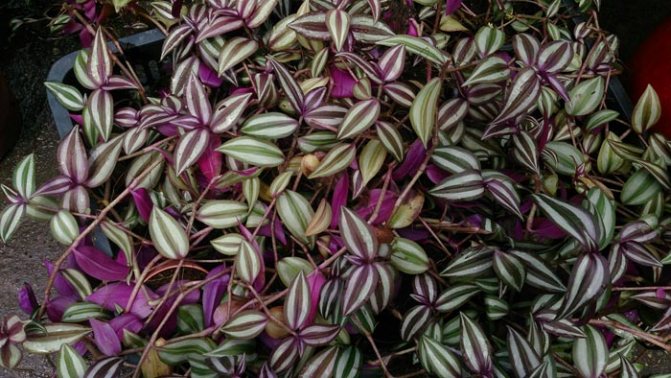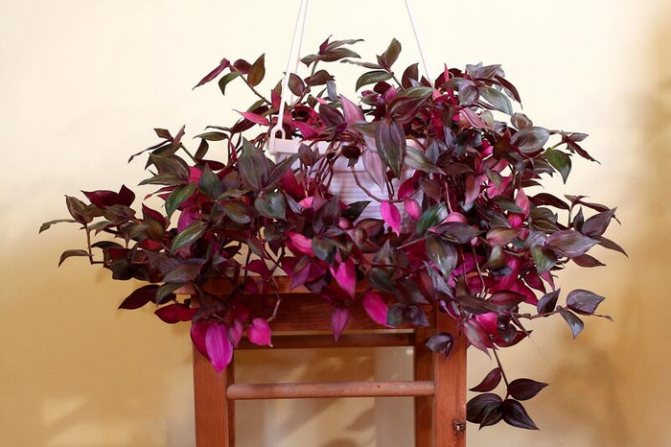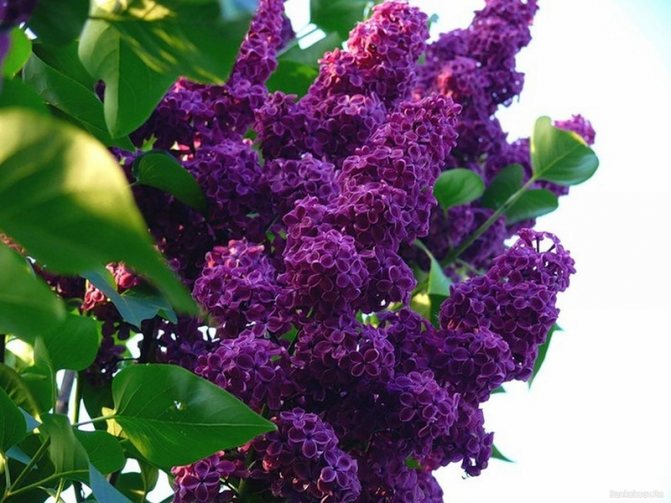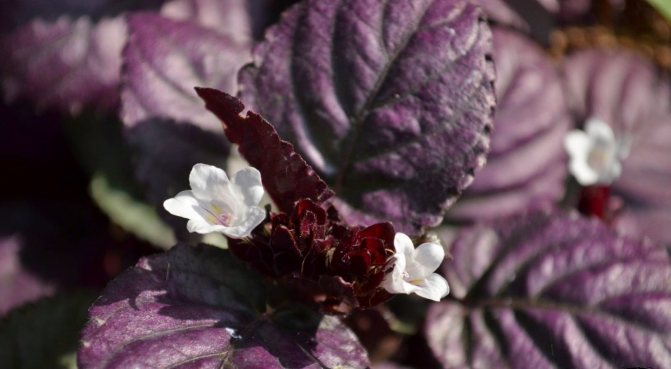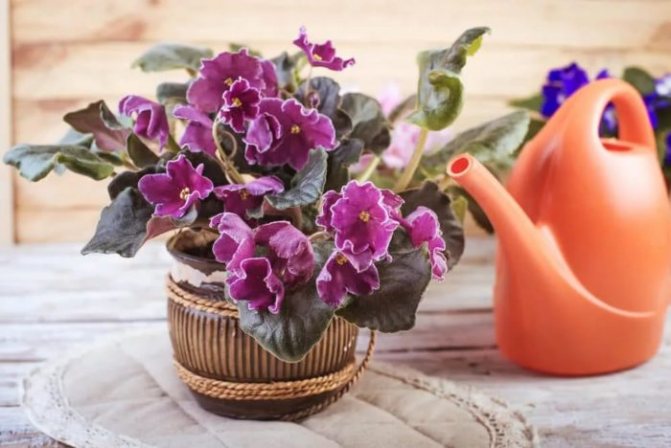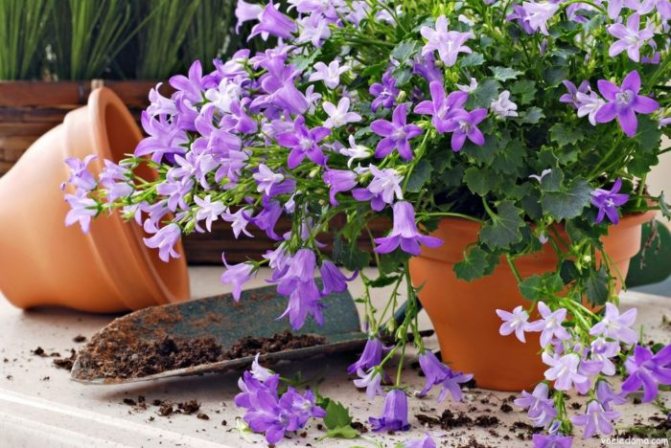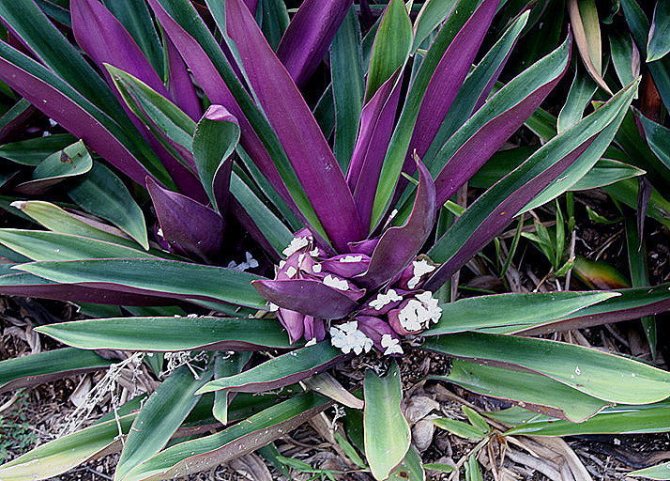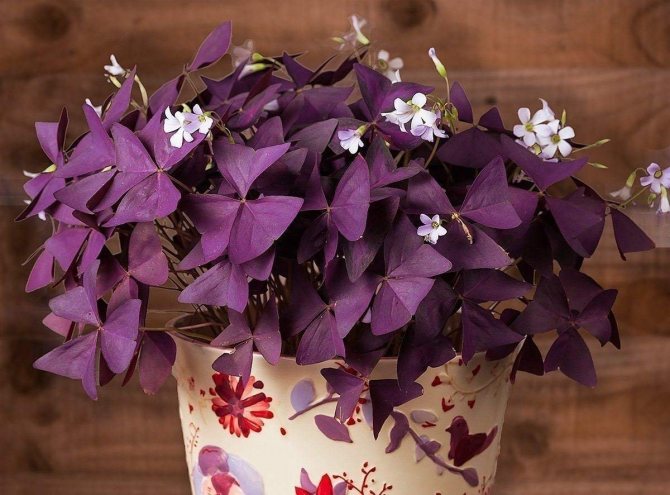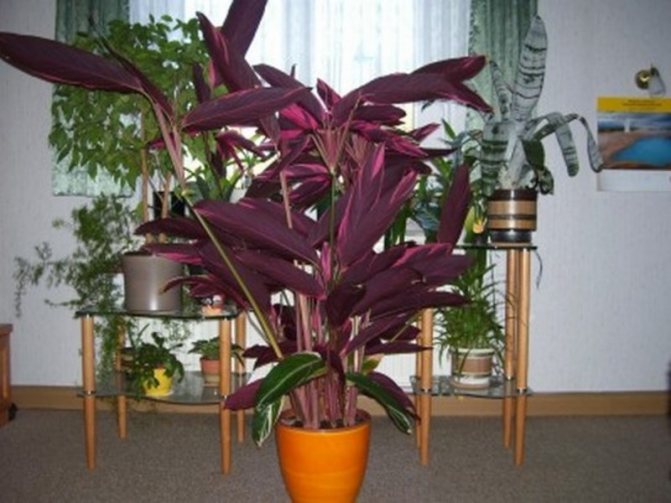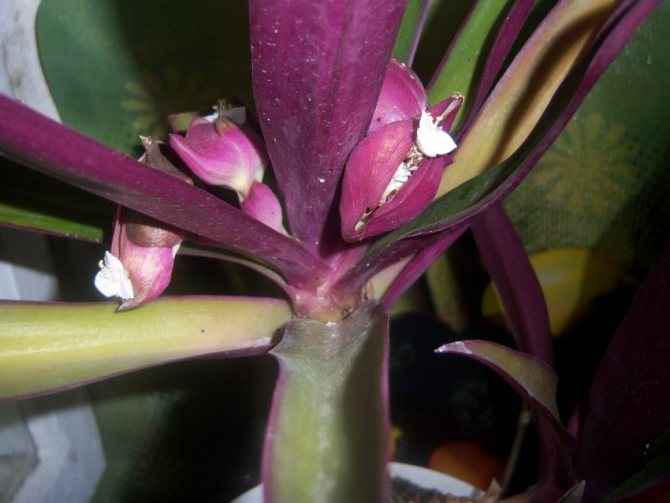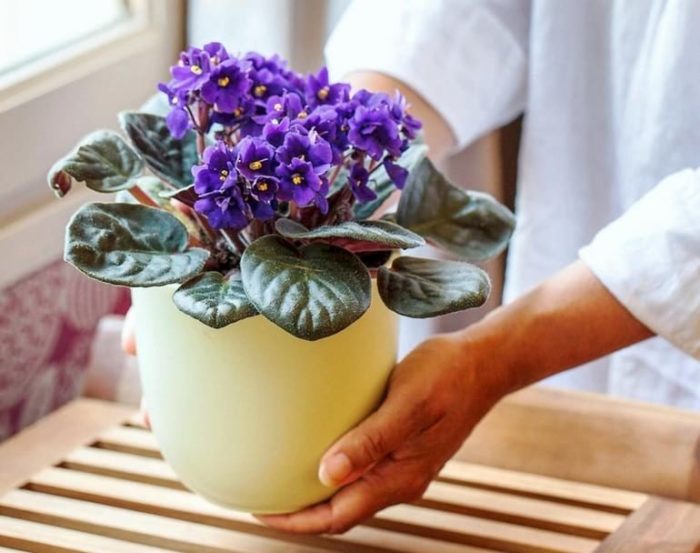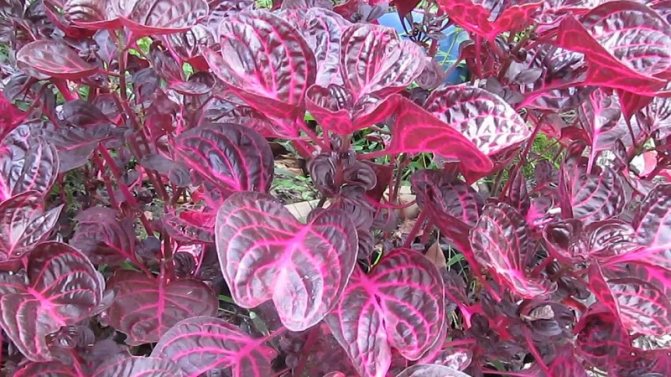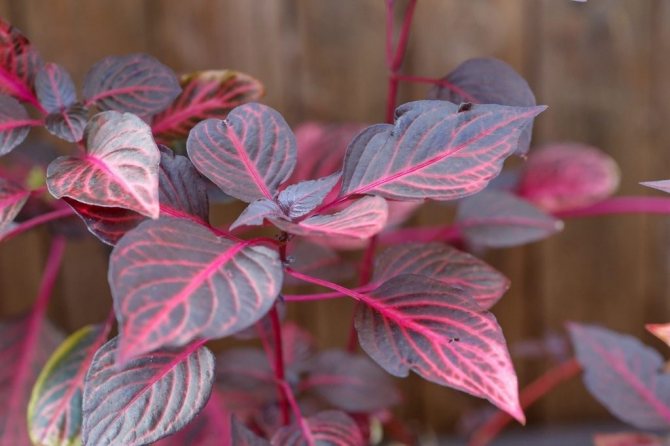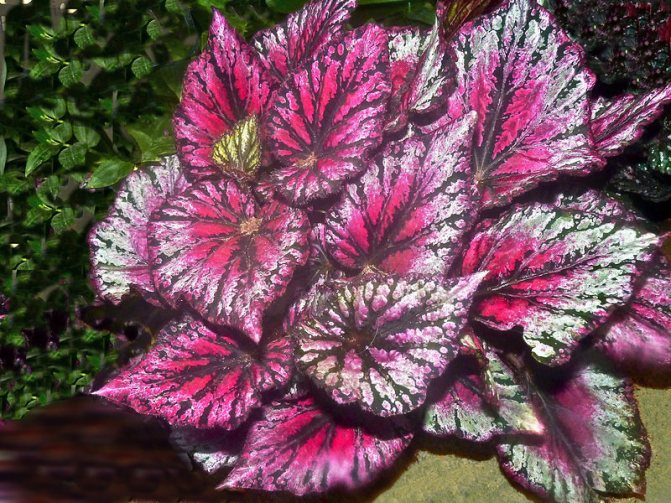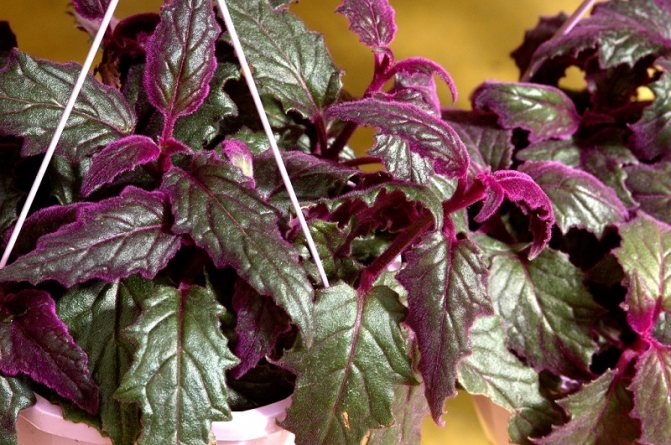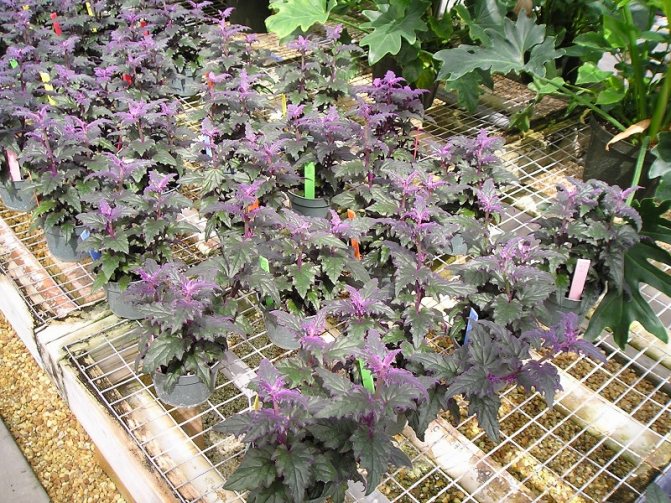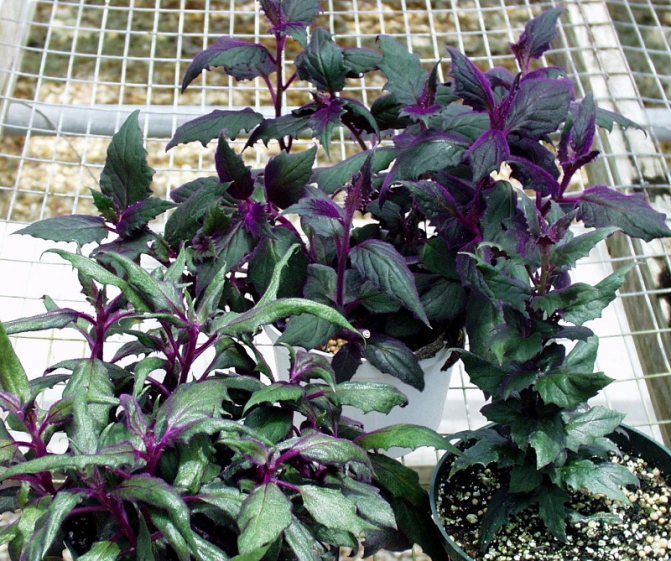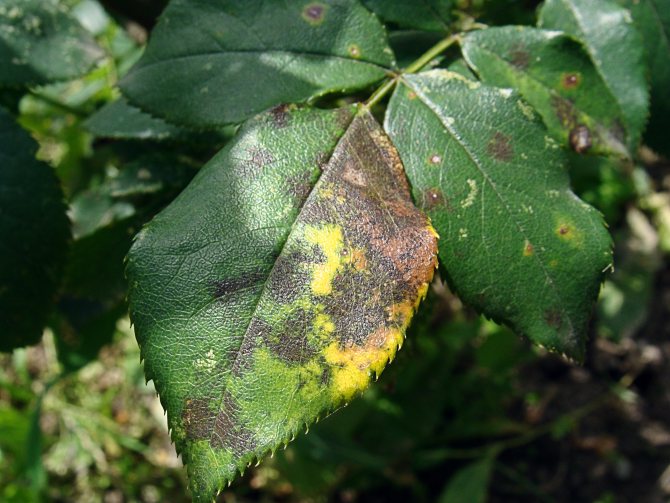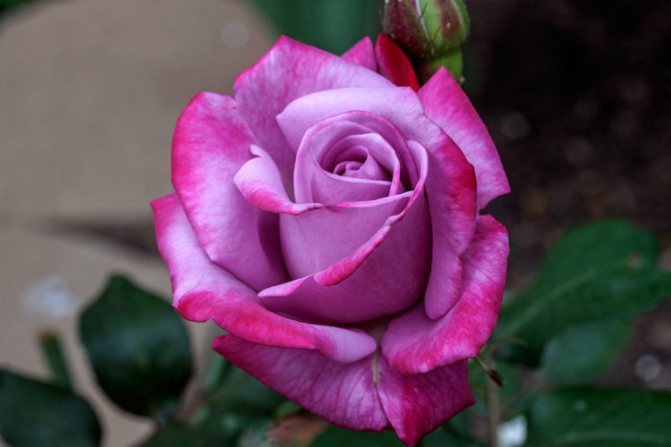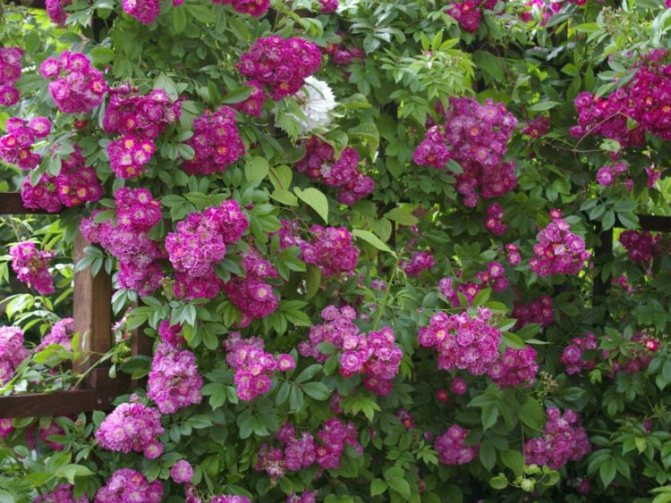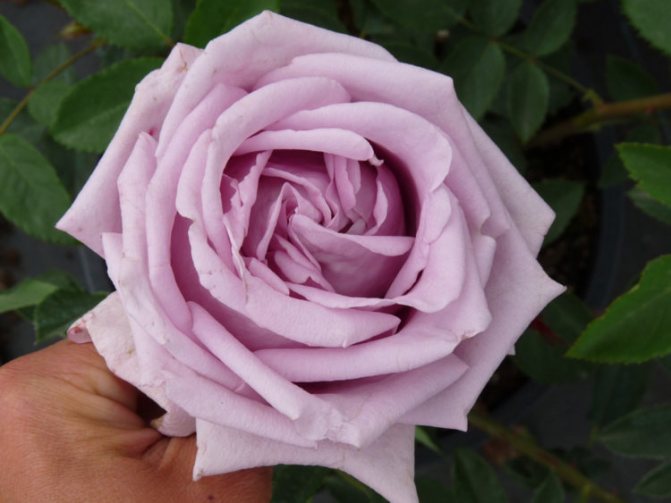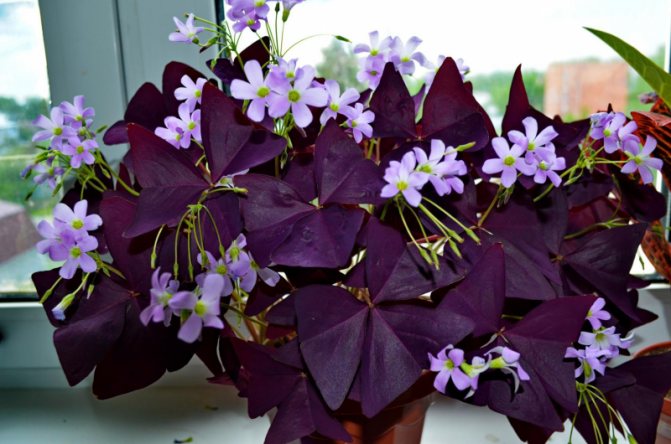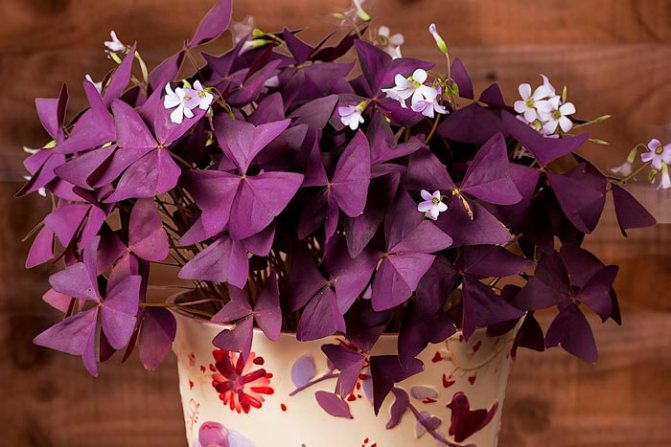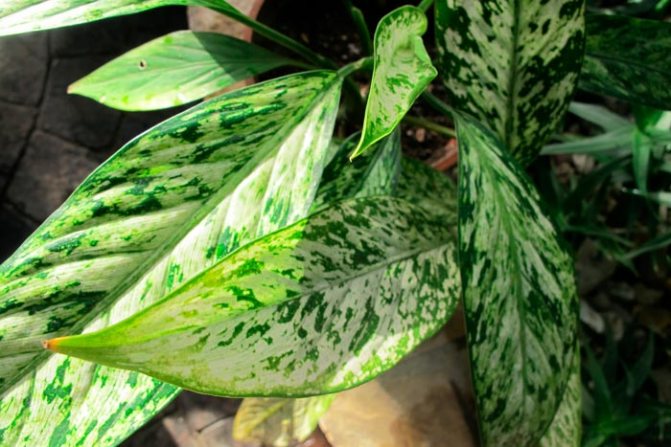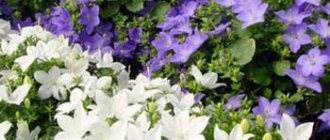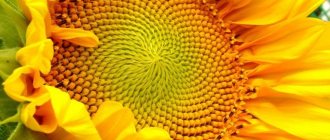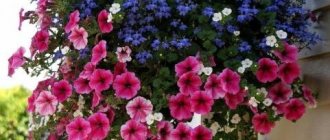Craftswoman Nature, skillfully playing with various colors and shades, creates incredible beauty compositions that you want to repeat on your personal plot. When forming a future pictorial masterpiece, the main stake can be made on the purple color, which conveys emotionality, great sensitivity, high spirituality and is optimal for meditation and contemplation.
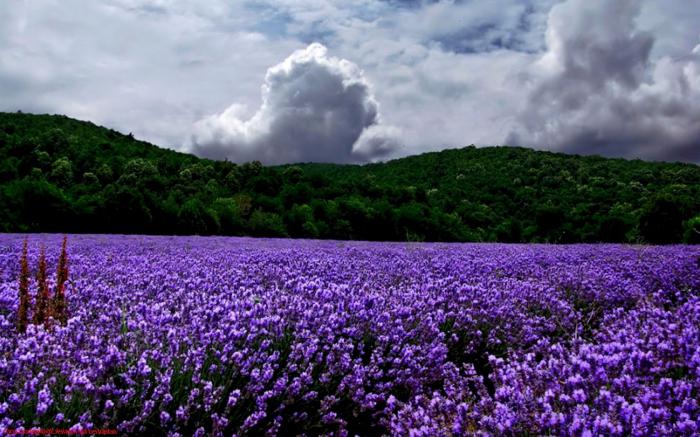
This "cold" color is ideal for dreamy people who are carried away in their fantasies far beyond the bounds of the possible, this favorite color of intellectuals and harmoniously developed people has a positive effect on brain activity.
Purple color: meaning
The color purple, located in the color palette between red and blue, is associated with mysticism in various countries. It is considered a symbol of the night, hiding many secrets and mysteries under the starry cover. Purple flowers planted in garden beds look rich and rich; admiring them brings peace, tranquility and pleasure. In nature, there is a fairly wide range of flowers with a purple color, so it is not difficult to choose plants that will harmoniously replace each other throughout the season and harmoniously paint the garden with purple colors.
Features of the view
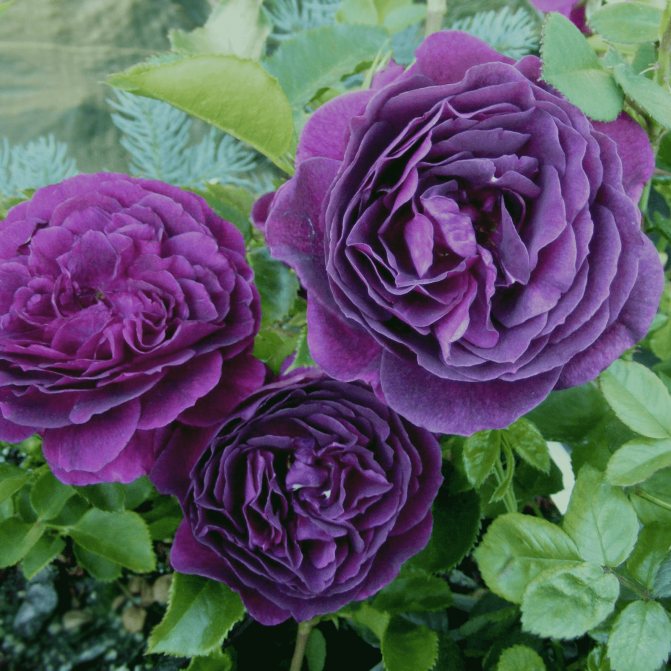

Roses with purple flowers fade in the sun, so on hot days they need to be shaded
Description and characteristics of varieties:
- Lilac roses combine a wide variety of flowers: climbing, hybrid tea, shrubs. All have petals of an exotic color, not typical of natural roses. Instead of the usual scarlet, white or pink, various shades of lilac prevail. Such roses are often called lilac, blue or purple, it all depends on the predominant shade.
- All purple or lilac roses are hybrids, the result of modern breeding. It was possible to achieve an unusual color by introducing a special gene that stains the petals of pansies.
- When growing purple roses, keep in mind that the petals fade quickly in the sun. Therefore, it is best to plant in an area that is well lit in the morning, and in the second - in the shade.
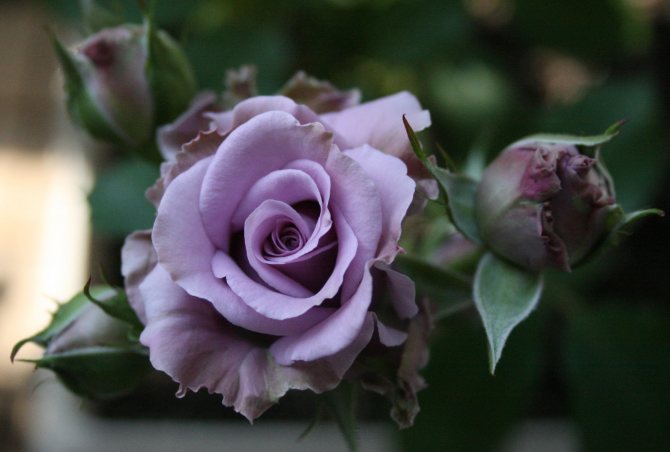

All varieties of purple roses are hybrids bred by breeders
The author of the video talks about the variety of purple roses Spray. Emphasizes abundant and long-lasting flowering:
Everyone's favorite lilac
First of all, at the mention of purple, a chic bush of fragrant lilac appears in thoughts - the primary culture of all parks and gardens, characterized by colorful large inflorescences and talking about the arrival of spring with its warm days. Purple-violet buds on tall bushes (about 4 meters), dark green leaves and a rare spreading crown will decorate any home garden with the variety of lilac "Twilight". A heady, strong aroma will charm you on spring evenings, and a luxurious bloom will delight you for about 3 weeks. Lilac varieties such as "Danton", "Maksimovich", "Mulatto", "Lady Lindsay", "President Poincaré", "Charles Joly", "Raj Kapoor" will decorate any garden, because they have gorgeous purple flowers.
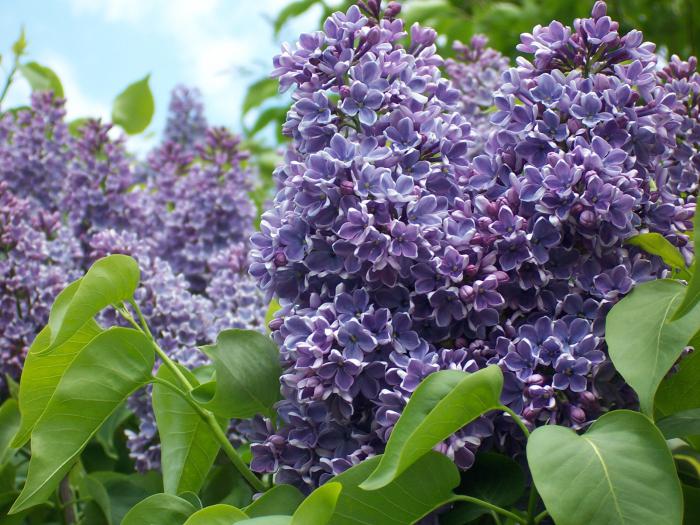

The photo conveys all the beauty of these gorgeous shrubs, loved by many gardeners.
How to plant purple roses correctly
Roses are planted in the ground in spring or autumn. In the spring, you need to wait until the soil has completely thawed and the temperature on it will be around + 10 ° C. In autumn, planting is carried out from mid-September to mid-October (depending on the region), so that the bush has time to take root before the first frost.
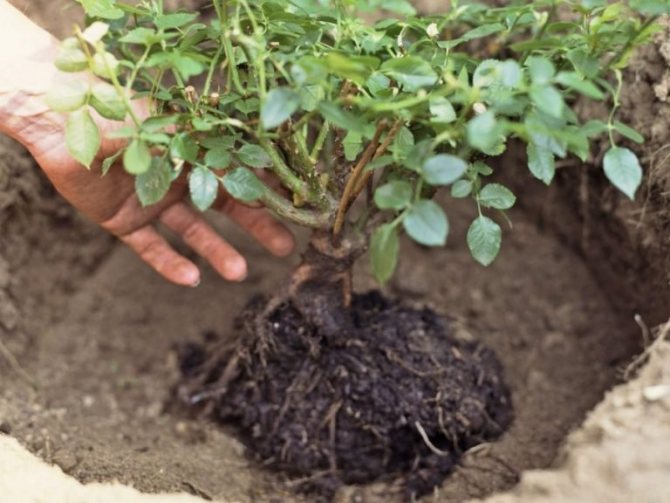

Pits must be prepared in advance, 2-3 weeks before planting. It is important to maintain the optimal distance between the bushes so that crowding does not cause fungal diseases, and too rare a placement does not lead to drying out of the soil and germination of weeds.
It is recommended to leave about 50 cm for floribunda and hybrid tea varieties, climbing ones need intervals of 1 m, and for semi-climbing and park ones it is better to leave about 1.5 m. For miniature plants, 25-30 cm will be enough.
Important! Climbing and standard varieties are laid and sheltered from frost, so you need to foresee a free space for shelter in advance.
The depth of the hole should be 10-15 cm more than the root of the seedling. On heavy, clayey soil, this size is increased by another 20 cm. Before planting, it is necessary to inspect the seedlings, remove damaged roots and stems. It is advisable to put the plants in water for a day.
On the day of planting, the roots are dipped in a clay mash of the following composition:
- 2 parts clay and 1 part fresh manure;
- 1 tablet of heteroauxin.
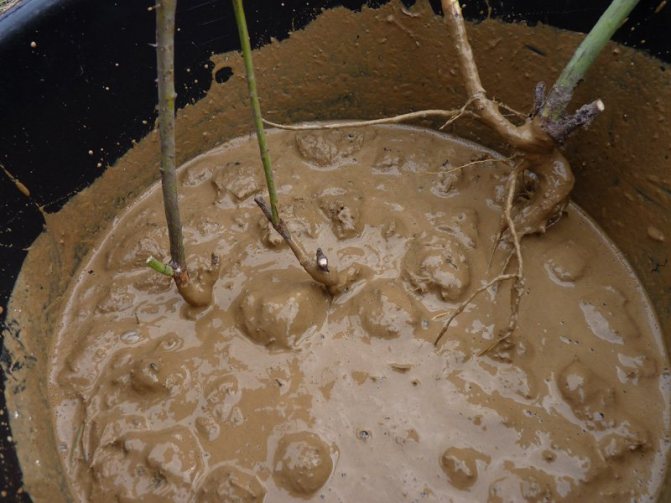

The mixture is diluted with water until sour cream is thick.
Then the bush is planted as follows (it is more convenient to work together):
- Pour part of the soil with a slide to the bottom of the pit.
- Lower the seedling and spread the roots up the hill. The grafting (budding) site should be 3-5 cm below the ground level, the roots should not bend up.
- Gradually sprinkle the bush with earth, compacting it with your hands and slightly trampling it down.
- Water the bush abundantly and check the graft site again.
- Spud the seedling with soil 20-25 cm and shade for 2 weeks.
In dry weather, plantings are watered every 4-5 days.
Crocuses - the purple charm of spring
Beautiful crocuses, the goblet flowers of which “scream” about the arrival of the long-awaited spring, will accelerate the departure of winter with splashes of purple paint against the background of melting snow. Reproduction of such beauty is not particularly difficult and consists in separating children from the mother plant, which in a year will please with the first flowering. To create an original composition, purple flowers are recommended, the names of which are given below:
- Nigro Boy - with dark purple flowers, purple at the base and having a barely noticeable light border at the edges of the petals.
- Paulus Potter - dark purple flowers with a reddish tint.
- Purpureus Grandiflorus - blooms with purple flowers, large (about 5 cm), dark at the base.
- Snowstore - white flowers with bright purple stripes at the base.
- Remebrance is a purple flower with a dark base and a characteristic silvery sheen.
- Flower Record - purple flowers with oval, elongated petals and characteristic pointed tops.
- Crocus Geufel is one of the largest species. The size of the purple flowers is about 7 cm.
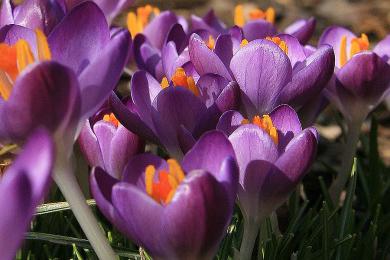

You can dilute the monogamous landscape with the colors of the sun using the Violet Queen variety, whose yellow-violet flowers add freshness, brightness and contrast to the composition.
Setcreasia purpurea (or Tradescantia pale)
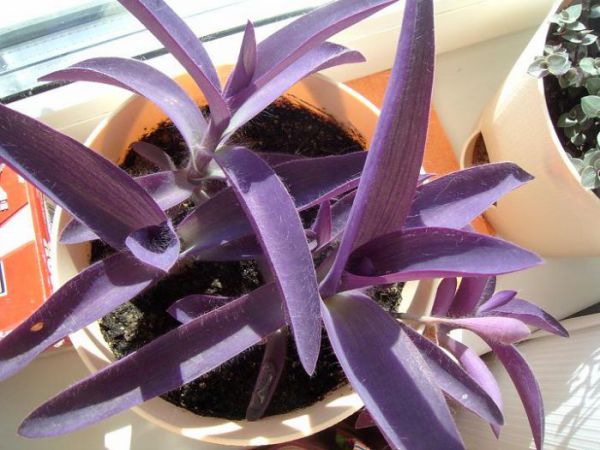

Setcreasia purpurea (or Tradescantia pale) is a very effective, unpretentious, hardy plant. Suitable for beginner growers. Often grown as an ampelous plant.
Growing conditions are simple:
- Lighting: Netcreasia purpurea loves bright spots, but it must be well protected from direct light. The brightness and saturation of the leaves depends on high-grade lighting.
- Air humidity: high. It is impossible to spray the netcreasia; it is better to put a vessel with water next to the pot.
- Temperature range: + 19-24 ° C in summer, + 12-13 ° C in winter.Keep the plant away from heating appliances.
- Watering: plentiful in warm weather, the soil should always be moderately moist, but not overflowed. Excess water can lead to decay of the root system.
- Reproduction: apical cuttings.
Irises are a decorative basis for any flower garden
Fading crocuses can quite harmoniously replace the beloved and universally cultivated irises (otherwise, reticulated iridodictiums). This flower has a large number of varieties, which are enough to create a gorgeous flower garden exclusively from irises. The noble plant is characterized by the graceful shape of large flowers, consisting of three (sometimes six) petal perianth lobes. The inner and outer lobes of the crop, which bloom in May – June, are different in shape, color and size. The sword-shaped iris, which has a beautiful purple flower and is characterized by late flowering, stands out for its original beauty. It is also called Japanese iris, since it was in Japan that most varieties of bearded irises were bred. The variety "Soserez Triumph" has an extraordinary color: almost blue petals, as if enveloped in purple cobwebs, on top of which the careless artist applied more yellow strokes.
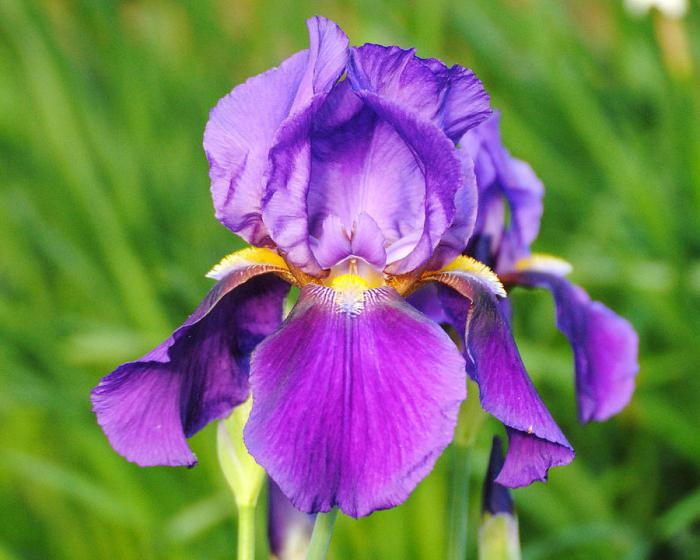

Violet paints diversify the flower garden such varieties as:
- Iris Russian, characterized by medium-sized fragrant flowers. This variety is undersized and suitable for growing in rocky areas.
- Siberian iris. The height of a fairly hardy flower is about 1 meter. Narrow-linear light green leaves, the absence of a beard on the outer perianth lobes are the main features of this species.
- Winners Sackle. Characterized by an abundant annual flowering, such a variety against the background of the rest is brightly distinguished by dark purple flowers with a white speck under a blue beard.
- Merion Made is a monochromatic light blue color with some shade of purple and a bright yellow beard. Its large flowers look original both on a flower bed and in a bouquet.
Ginura
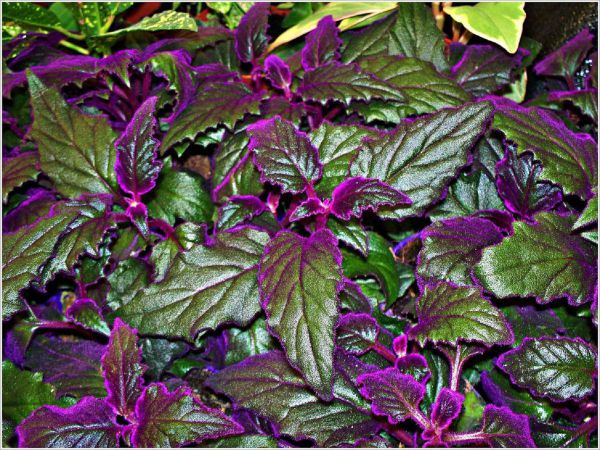

Ginura or "Blue Bird" is one of the most colorful and adorable representatives of this collection. By the way, the full name is Ginura Orange (which is very unusual, because the plant is not colored orange). In the leaves of ginura, not only the combination of bright purple and green is beautiful, but also the velvety surface of the leaves. The shaggy plant is very decorative and interesting. Pay attention to the edges of the leaves: they are framed by teeth.
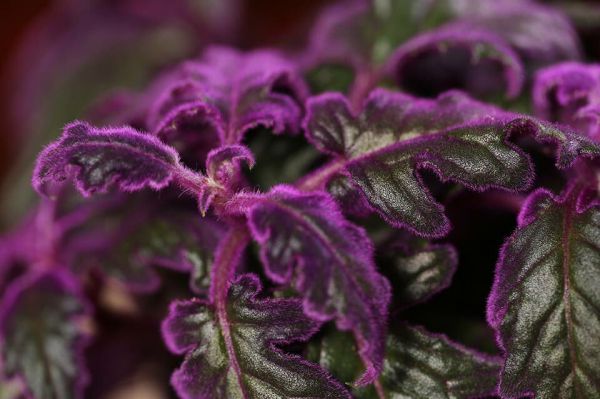

Important! Ginura is a poisonous plant, so you need to work with it exclusively with gloves. It is necessary to protect children and pets from contact with the plant.
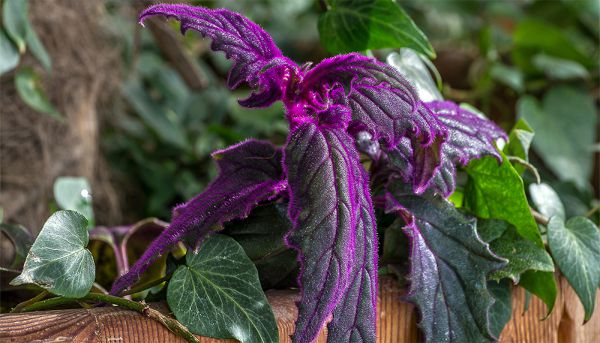

Features of growing the Blue Bird:
- Lighting: A lot of ambient light is required, but it is important to avoid direct sunlight. West and east windows will do.
- Air humidity: there are no requirements, ordinary room indicators will do, excessive humidity will negatively affect ginura.
- Temperature regime: in the warm season 20-24 degrees Celsius, in winter it is better to lower t to 15.
- Watering: very gentle, along the edge of the container. Excess moisture is destructive, while the water should not get on the leaves, shoots, flowers. In spring and summer, it is necessary to maintain a constant moderate soil moisture, and in winter, the procedure is rarely carried out when the earth is half dry.
- Reproduction: cuttings, while cuttings are very easy and quick.
- Ginura should receive fresh air regularly, but at the same time it should be protected from drafts.
- After several years, the plant loses its decorative effect. Therefore, it is required to replace old bushes with young ones. Transplantation of young specimens is carried out, as a rule, every two years.
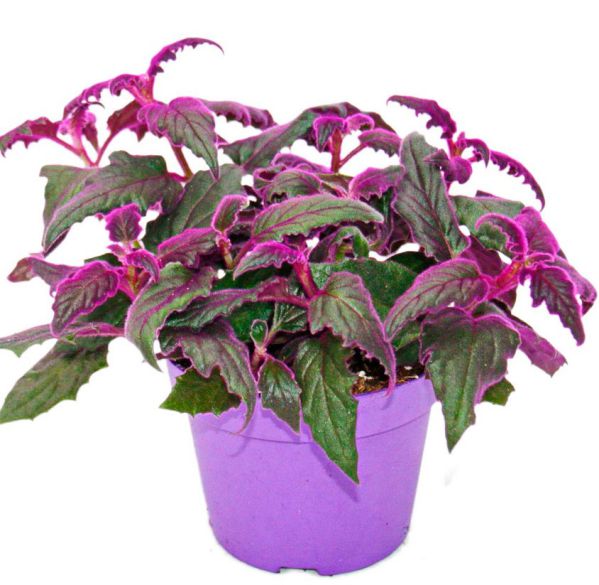

By the way, the plant is valued for its decorative leaves, but the bloom of ginura is very graceful. Lovers of minimalism will like it.However, the flower has an unpleasant odor, and can also take strength into the bush to the detriment of the overall decorative effect, therefore it is most often cut off.
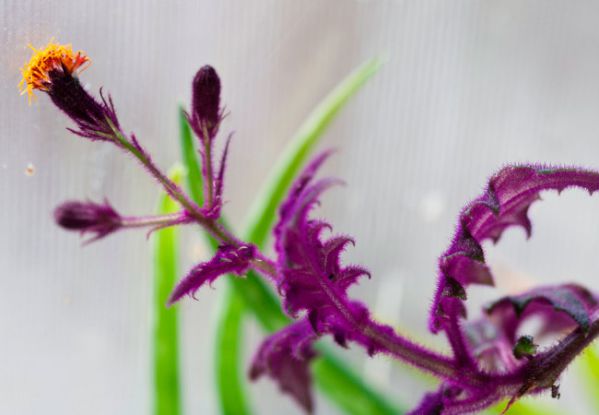

Hyacinth is an indispensable component of the purple palette
Speaking of flowers that bring bright colors to garden beds, it is worth mentioning purple flowers, the names of which, translated from Greek, mean "rain flowers". These are hyacinths. Strong, luxurious, dense inflorescences conquer with their pleasant aroma, delicate beauty and rich color palette, in which purple is effectively represented.
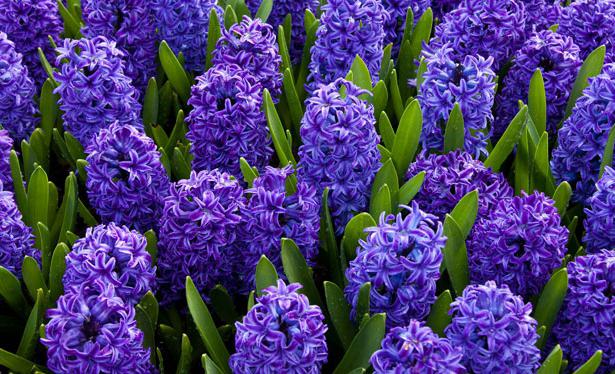

These are such varieties as "Blue Jacket" and "Ostara", which have a blue-violet color; the blue-lilac shade is characterized by "Peter Stuvisent"; Woodstock and Maria are dark purple varieties, Bismarck is a light purple flower, Miss Saigon is purple red.
Optimal growing conditions
Growing roses requires attention and a careful approach from the gardener, but the lush and long flowering justifies all the costs. Most purple roses do not have any special differences in placement and care from varieties of the same group (floribunda, scrub, climbing, etc.) with petals of other flowers.
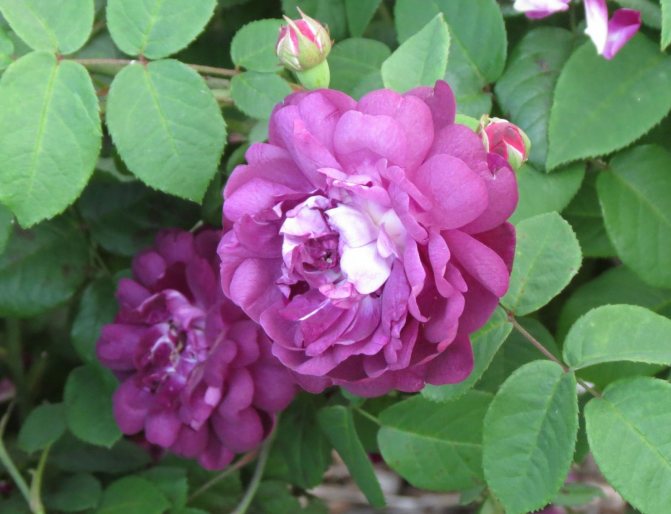

Location
Roses are preferred in places with good lighting and medium airflow. To avoid color fading, it is better to plant purple varieties where there will be light partial shade in the afternoon.
A wall or fence can be a good protection against possible drafts.
Basic soil requirements
The main requirement for the soil is good drainage and a sufficient amount of nutrient organics, which also retain moisture. The acidity should be in the range of 6-7 pH, close to neutral.
Important! Do not plant roses where other rosaceous plants grew: quince, hawthorn, cinquefoil, cherry, apricot, pear, or other roses over 10 years. But if you want to plant them exactly in such a place, there is a way out: the land on this site must be replaced by a depth of about half a meter.
Roses are extremely sensitive to flooded areas, where their roots die from lack of oxygen. In winter, such soil freezes more strongly.
This unusual purple tulip
Tulips continue the purple wave of bloom, in particular varieties such as Treveler, with its beautiful deep purple hue, Chanson, characterized by dark blue-violet goblet flowers trimmed with white contrasting border. Variety "Alibi", characterized by a light purple color and purple-dark, almost black with a white "Jackpot" edging. Lily-violet flower "Burgundy" and purple with a white border variety "Ballada" will stand out for their original color in a well-arranged floral arrangement. "Pierple Dream" diversifies this purple collage, complementing it with a red tint.
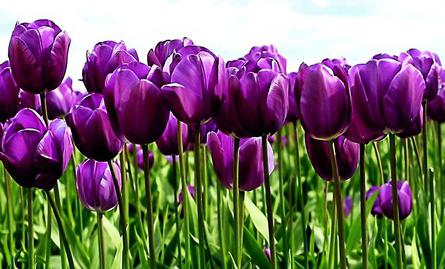

The decorative onion blooms with purple flowers, various varieties of which can be used as a worthy decoration of any flower bed. These are the Aflatun bow, the Karatav bow, the giant bow, the Christof bow.
Description of the best varieties of purple roses
Petals of shades of purple, blue or black are not found in nature, so all the plants presented are hybrids. Plants with petals of various shades of purple, as well as those close to lilac, are ranked as purple roses. It should be noted that the color also depends on the growing conditions, which is described in more detail in the corresponding section.
Did you know? Natural rose varieties do not have the blue pigment delphinidin. In 2004, the Japanese company Suntory used genetic modification and was able to produce a blue flower with a touch of lavender, which was named Applause.
According to experts and amateurs, the best varieties of purple roses are several presented below.
Cardinal de Richeliau (Cardinal Richelieu)
It has been known since 1847 and belongs to Gallic or French roses, however it has an unusual set of chromosomes and can be a hybrid with a Chinese rose. Small double flowers have a rich purple "dark grape" color.
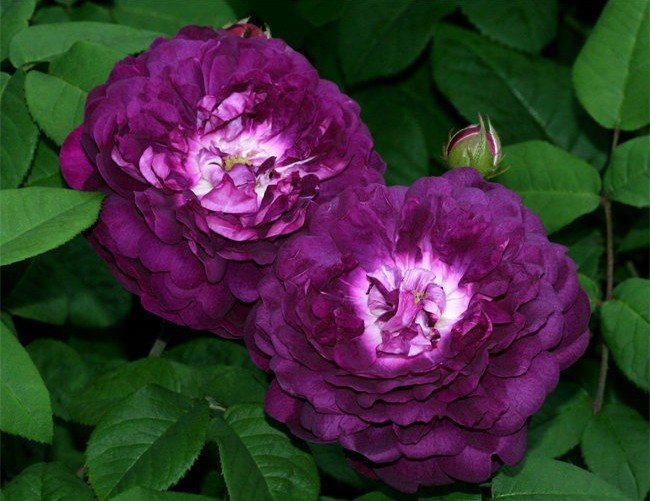

The features of a flower and a bush are as follows:
- flower size 5-6 cm, they are collected in small brushes;
- petals with a lighter underside and white spots at the base;
- light, peppery aroma;
- flowering once, lush, 4-5 weeks;
- bush height from 150 to 175 cm, width 150 cm;
- shoots are thin, drooping, with a minimum number of thorns;
- winter hardiness up to -30 ° С;
- prone to black spot.
Claude Brasseur (Claude Brasseur)
Refers to hybrid tea roses. The French variety from Meilland appeared in 2006. Large lavender flowers have been highly appreciated by connoisseurs.
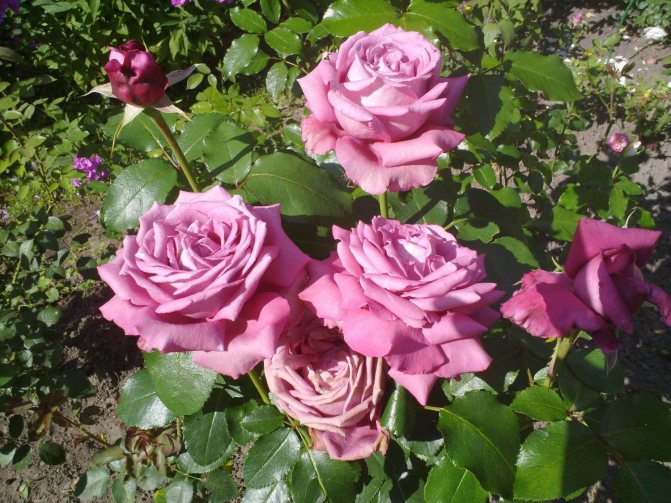

Variety characteristics:
- flower size 13-14 cm;
- purple-purple petals of different saturation, 75 pieces per flower;
- rich aroma with notes of verbena and lemon;
- lush flowering, in two waves;
- bush 70–90 cm high, 50 cm wide;
- good winter hardiness;
- marked susceptibility to rose rust.
Tea-hybrid roses also include such varieties as: Osiria, Avalange, Mondial and Svitnes.
Night Owl
Large-flowered climber (climbing rose with thick shoots) of American selection from 2005. Semi-double flowers with yellow stamens appear on the characteristic tall and tough, erect stems.
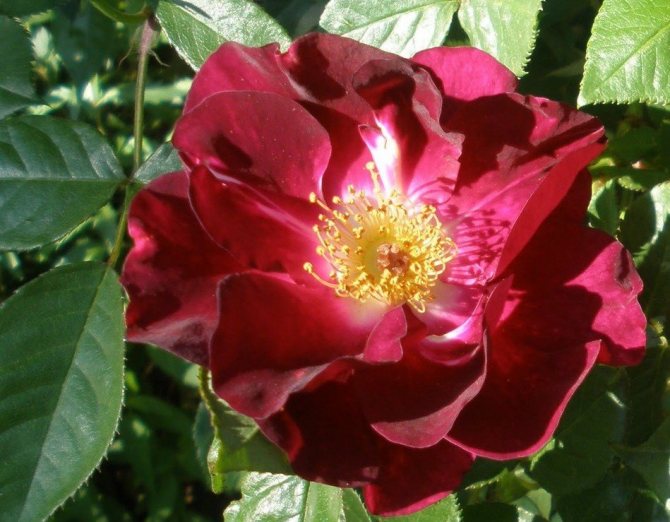

Other features of the variety:
- flower 9–11 cm in diameter, purple-violet, brightens towards the center;
- 3-5 flowers on one stem;
- aroma of medium saturation, with notes of spices, cloves;
- flowering in two waves;
- bush from 305 to 425 cm high, strong, almost without thorns;
- frost resistant.
Purple gladioli in the garden
Gladioli are a decoration of any flower bed. Purple flowers are of such varieties as "Joseph Gulot", "Peregrina blue-violet", "Try Bru", "Blyauer Triumphant", "Bl. Admiral "," Feichenblyau "," Othello ". The variety "Aida" stands out with dark purple flowers, red inside. Violet-blue flowers of the Blyau Shengayt variety will diversify any flower arrangement. The variety "Pearl Flora" has rich dark-purple flowers, which will look very harmoniously next to the variety "Belladonna", whose pink-lilac flowers will only decorate the composition.
Diseases and pests
| Black spot Stages of the struggle:
|
| Rose leafhopper Stages of the struggle:
|
Clematis is the basis of vertical composition
Climbing plants are an indispensable attribute of a vertical garden, many of which boast purple flowers. Violet Clematis and Jacquemann's Clematis are characterized by abundant flowering. Such a purple hedge with light stripes, which are bordered by clematis flowers, will brightly decorate the garden, revitalizing it to the fullest. The clematis variety "Luther Burbank", planted on the outside of the garden composition and blooming with large purple flowers, will catch the enthusiastic gaze of more than one passer-by.
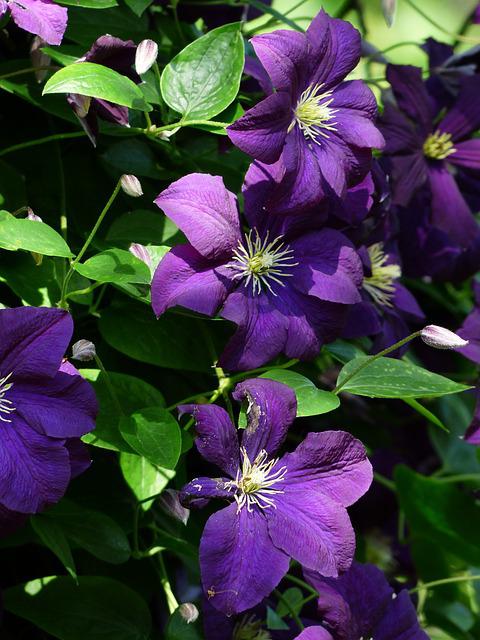

With a blue tint, the purple composition can be diversified by the variety "Minister", the flowers of which are also decorated with a purple-violet stripe.
Zebrina (or Hanging Tradescantia)
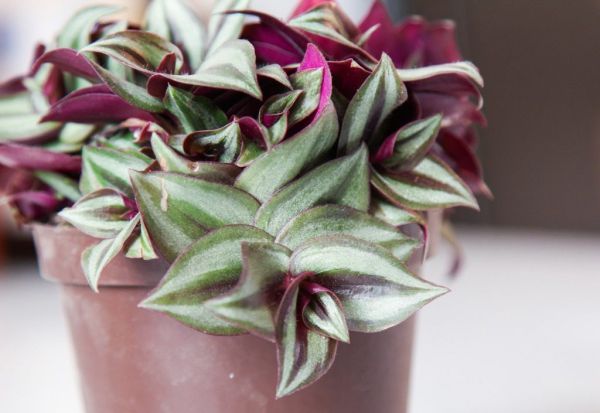

When growing a beautiful plant, there are no particular difficulties, because it is quite unpretentious. Moreover, it is growing rapidly. Zebrina is loved by many growers because of its spectacular leaves.The upper surface of the leaf has silvery green stripes on a pale purple white background, and the underside is tinged with a deeper purple. However, in order for the leaves to please with their decorativeness, good lighting must be provided.
Basic requirements for growing a zebrin:
- Lighting: full bright lighting is necessary, but one should be a little diffused so that direct rays do not burn the zebrin. However, in the morning and evening hours, direct sun exposure will be beneficial.
- Air humidity: normal room humidity, loves spraying.
- Temperature regime: in the warm season - 18-25 degrees Celsius, in the cold - 13-15.
- Watering: in spring and summer, abundant, it is necessary to maintain moderate humidity, in winter to water less often, but not allowing the earthen coma to dry out.
- Reproduction: cuttings.
- An important feature: the root system of the plant is weak, so moisture deficiency cannot be provoked. Also, for planting, you need to choose a wide and shallow container.
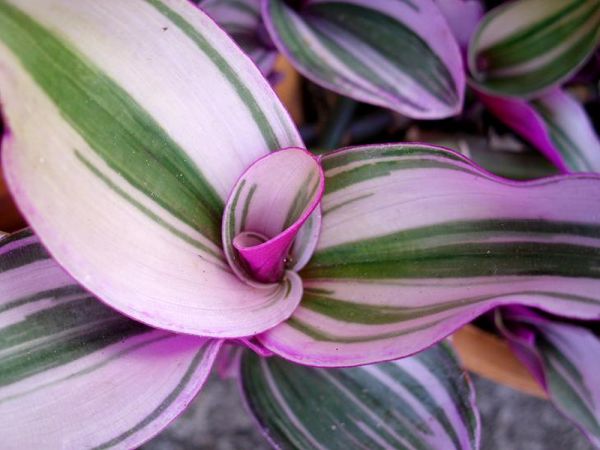

By the way, the ampel plant is ideal for growing in hanging pots and ordinary pots, looks good as a ground cover plant.
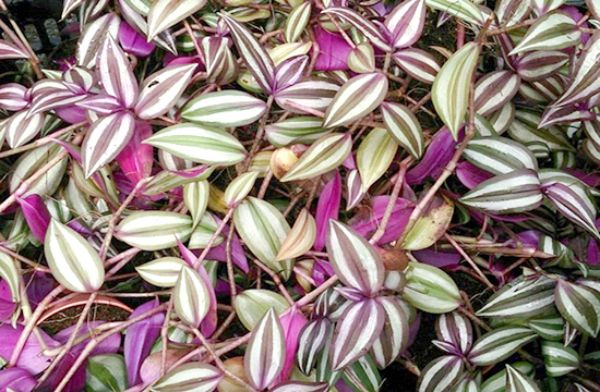

Kislitsa - an indoor miracle
A plant such as oxalis, which in Europe is called the "clover of happiness", can "ophiolet" indoor compositions. According to popular beliefs, it attracts good luck to the house in which it grows. In this case, it is worth observing the following condition: the oxalis must change its owner on the last day of the outgoing year. Therefore, on New Year's Eve, this plant with purple leaves is considered the best gift. It is the sorrel shamrock, symbolizing the Holy Trinity, that is the national symbol of Ireland, depicted on its coat of arms.
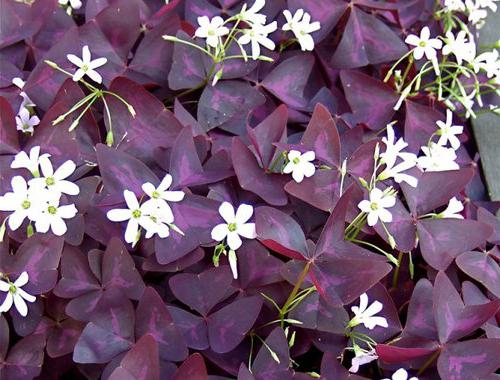

A characteristic feature of such an unusual houseplant is the folding and lowering of its leaves at nightfall or in cloudy weather. This gives the impression that the flower with purple leaves has turned into a flock of butterflies; that is why sour cherry is also called "Madame Butterfly" and "butterfly flower".
Zebrina is a houseplant characterized by oval leaves with a shiny surface, colorful at the top and purple at the bottom.
The violet-white flowers of the common violet will decorate any room in which it grows. A fabulously beautiful plant delights with a variety of shapes and shades. The violet is used for indoor cultivation. She also feels great outdoors, especially in the shade of trees.
Reo (or Covered Tradescantia)
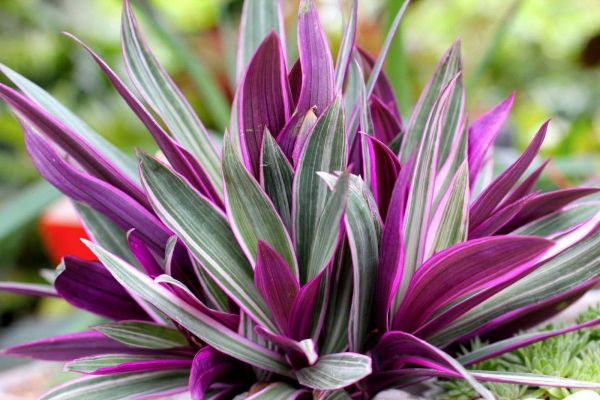

Reo, Covert Tradescantia, Multicolored Tradescantia are different names for one decorative leafy plant. Thanks to the graceful curvature of the leaves, the tropical culture has a beautiful silhouette. By the way, in the summer, the pot of rheo can be taken out into the garden or on the balcony.
Covered Tradescantia needs the following conditions:
- Lighting: Rheo grows normally in light, but diffuse lighting is required, it is also important that the plant is protected from direct sunlight at midday. Can be grown on the east, west, south windowsill.
- Temperature: in the warm season - 20-23 degrees Celsius, in the cold - 18-20. It is important to avoid sudden changes in temperature.
- Air humidity: high humidity is very important for this culture; in favorable conditions, the rheo will look as decorative as possible. Due to the dry air, Tradescantia cape will stretch and age quickly. Especially in hot weather and during the heating season, it is important to increase the humidity in the apartment.
- Watering: abundant, it is important to maintain a stable moisture content of the earthy coma, only the top layer of the soil can dry out. In winter, watering is carried out less often, it should be watered a couple of days after the top layer of the earth in the pot has dried. Although the plant is moisture-loving, excess moisture and dampness of the soil are harmful and even dangerous for it, by the way, as is the excessive dryness of the substrate. It is also very important that moisture does not get on the leaves!
- Reproduction: cuttings of lateral shoots.
- It is also important that the room in which the rheo is grown has adequate ventilation and fresh air circulation.
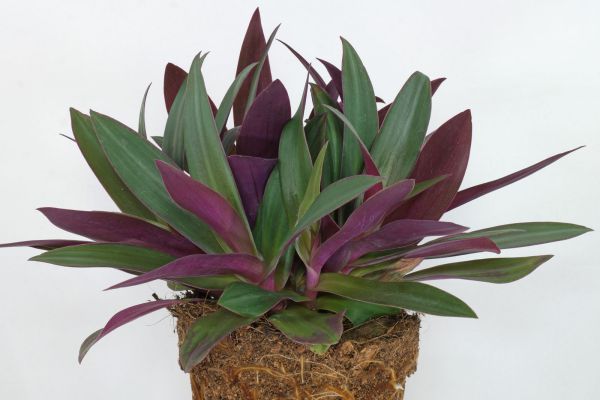

Hemigraphis
Hemigraphis has purple foliage and is grown in hanging pots or baskets. The leaves are silvery and purple in color. Such a plant is demanding for warmth, especially in winter, it needs moist air, and regular pruning of too long stems.
The bush can grow to a height of 45 centimeters, its leaves are oval and wrinkled in structure. In winter, the minimum temperature in the room should be from 13 degrees Celsius, an illuminated or slightly shaded place is chosen, if the plant is exposed to direct rays of the sun, the color of the leaves becomes saturated. Abundant watering must be ensured in summer, and in winter, the procedure should be moderate, mandatory spraying of the foliage. Every year the bush requires a transplant; it can be propagated by cuttings.
The benefits and harms of the rheo flower
Rheo is rarely considered as a home healer, but traditional medicine recommends using a plant:
- with rheumatism (in the form of compresses);
- wounds on the skin (the sheet needs to be crushed, put on a problem area and bandaged);
- in case of intestinal diseases (they use a decoction inside, which was prepared for 20 minutes).
The indoor flower rheo also has a number of useful mystical properties: endowing a person with creative energy, dedication, neutralization of aggression. Folk omens and superstitions say that this flower protects its owners from witchcraft, protects from love spells.
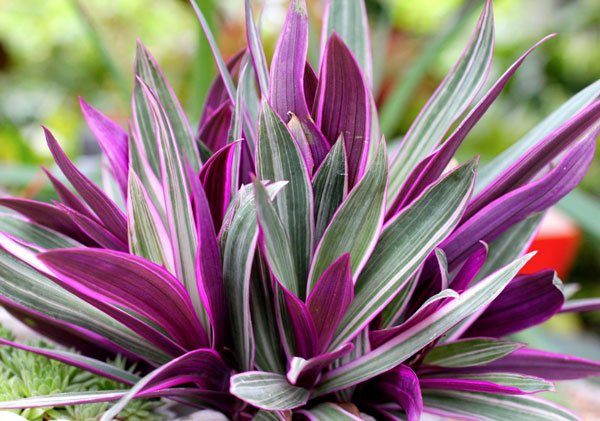

Unfortunately, if a person took care of the green pet itself badly and the plant got sick, then it begins to emit negative energy into the atmosphere of the room, which means it will involuntarily harm people.
... as well as about signs and superstitions
Due to the dual nature of the plant, it gives the room, and with it people, creative energy, and neutralizes aggression. It also focuses on the result, helps to complete unfinished business. In some sources, the indoor flower Reo is endowed with the magical properties of a talisman against love spells and witchcraft spells. It is worth noting that under the influence of the sign of Aquarius, this purple indoor plant has a positive effect on the circulatory and cardiovascular system. The indoor flower is ruled by such celestial bodies as the Sun and Mars. The patronage of the Sun contributes to endowing the atmosphere in the house with nobility and high beautiful feelings. Under the influence of Mars, Rheo absorbs aggressive vibrating latent energy.
Explanation of some names
Meadow flowers, in addition to the official Latin name, have a name that was given by people. For example, coltsfoot got its name from the contrast of the upper (warm, fleecy) and lower (cold, smooth) parts of the leaf.
Elecampane relieves fatigue, gives "nine forces". Cornflower is a symbol of purity and holiness, named after Saint Basil, who loved flowers with great love. Ivan da Marya is named according to the legend of unhappy love, which was not destined to come true.
According to the Russian legend, multicolored pansies are the color of hope, surprise and sadness of a girl whose heart could not stand the vain expectation of her beloved. The carnation was named for its resemblance to an ancient forging nail. The roots and leaves of gentian are so bitter that this taste is the name of the flower.
Photos with the names of wildflowers are shown below.
Ivan da Marya
Pansies
Meadow carnation
Proper care of Kislitsa
When caring for such a plant, it is important to provide the correct lighting, temperature, and watering. For Kislitsa, they choose a place in partial shade so that the flowering is long, it is better to put the flower in a cool place, and provide it with lighting. If the plant does not have enough sunlight, the foliage turns pale, shrinks, and the stems become elongated.If the conditions are too hot, and the direct rays of the sun fall on the bush, then weak flowering occurs, and burns may appear on the leaves. Therefore, Kislitsa must be shaded from direct sunlight. In spring and summer, the temperature in the room should be up to 25 degrees Celsius, and in autumn and winter - up to 18 degrees.
When the bush blooms, it needs to provide frequent watering, and spraying the foliage with settled water. Top dressing is carried out from early spring to early September every three weeks. Usually a solution of mineral fertilizers is used, its concentration is halved in comparison with the instructions. They take care of the purple plant not only in summer, but also during dormant periods, that is, in winter. A cooler place is chosen for the flower, but the temperature in the room should not be less than 10 degrees, you can place the plant on the windowsills on the north side. Watering is carried out rarely, as needed, and spraying is not carried out at all. When the bush gives young shoots, it is rearranged to the place where it stood before, so that all conditions satisfy the flowering process.
Young bushes need to be replanted annually, and for adult plants, the procedure is performed once every three years, the soil is regularly loosened. For planting, you need to take peat, deciduous, humus soil, and sand, all components should be in equal amounts, and three times more peat is added. You can purchase ready-made soil in specialty stores. Pebbles are poured at the bottom of the container, which serves as drainage, and does not allow excess water to stagnate in the pot. To make the plant look more decorative, several bushes can be planted in one container. Regular loosening of the soil is a must.
Gemigraphis
In the wild, it is an evergreen perennial. Today there are more than 100 species growing in natural conditions. Cultivated at home, only 4 items are suitable for growing:
- Wide crimson. A low-growing plant, shoots are painted red, spread widely. When the stem touches the soil, it quickly takes root due to the presence of nodes on it. The tops are raised upward. The leaves are lanceolate, along the edges there are notches up to 6 cm long. Above the plate is violet-green, the reverse side is red-violet. At the top of the stems are inflorescences in the form of heads, collected from small petals, the entire bud does not exceed 1.5 cm in length. The color is white.
- Alternate... The second name is red ivy. The length does not exceed 50 cm. The shoots spread, have a brown tint, the tops rise to a height of 7 cm, take root in the nodes. Leaves are ovoid, up to 9 cm long, shaped like a heart. Above, the color is silvery against a gray-green background, below it is lilac or violet. The surface is glossy. The petioles are short, up to 5 cm, brown, pubescent. The flowers are white, inconspicuous, no more than 1 cm long, bell-shaped. Can be used as a ground cover or ampel form.
- Colored (flaming ivy). Herbaceous perennial, grows in the form of a bush, found in the wild in Java and the Philippines. Up to 25 cm high, it has creeping shoots that take root easily on the soil surface. The leaves are shriveled, violet-blue with a silvery tint on top and a red tint below. The flowers are white, small and almost invisible.
- Exotic. This variety is used to decorate terrariums and aquariums, as well as a house flower. It reaches a height of 40 cm, the leaves are purple with green spots, on the reverse side - red with veins. If the plant is grown in cold water aquariums, the foliage will turn a solid green. The stem is straight; flexible lateral processes grow on it.
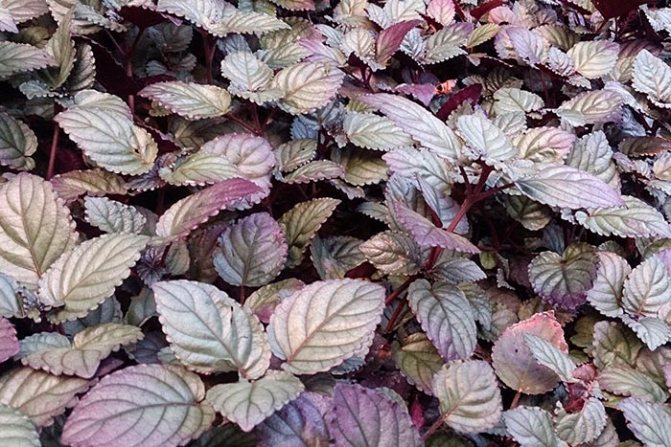

Alternate
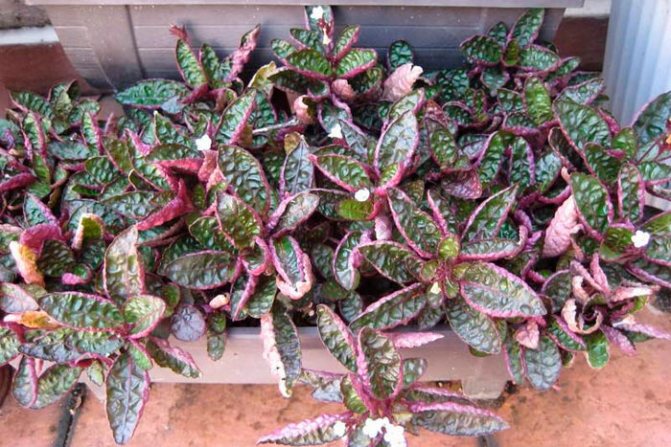

Exotic
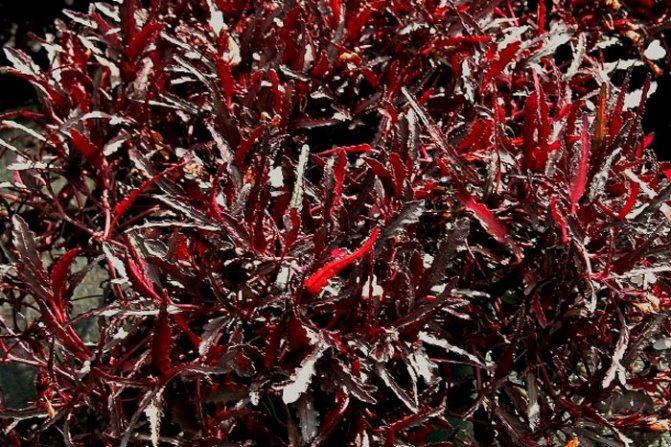

Wide mousy
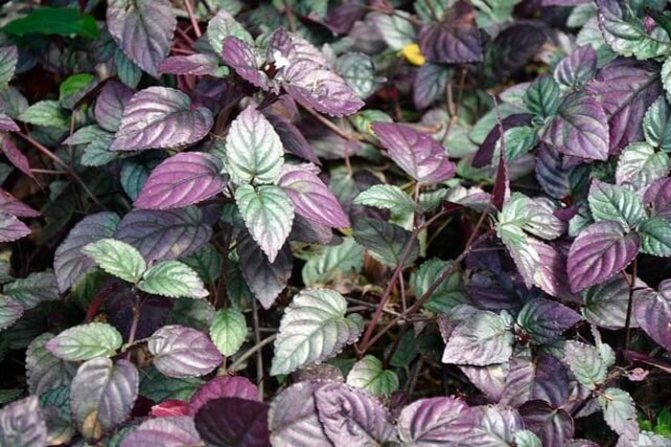

Color
General description:
- ground cover plant, with herbaceous, creeping nodules-shoots, rising up;
- leaves have different shades of purple with dark green streaks or spots that turn silvery in daylight;
- leaf plates are located on short petioles, can be ovoid and lanceolate, small denticles are located at the edges;
- nondescript white flowers are collected in bunches, up to 1.5–5 cm in diameter, in the form of spikelets;
- the plant forms aerial roots, which are used for reproduction and cultivation as an ampelous species.
The beautiful bright leaves of the hemigraphis with silvery stripes overshadow the faded, almost invisible flowers. The height of the bush in culture reaches 15-30 cm, in the wild - about 60 cm. The diameter of the bush is 45 cm.
Top 10 plants with lilac and purple petals
Crocus
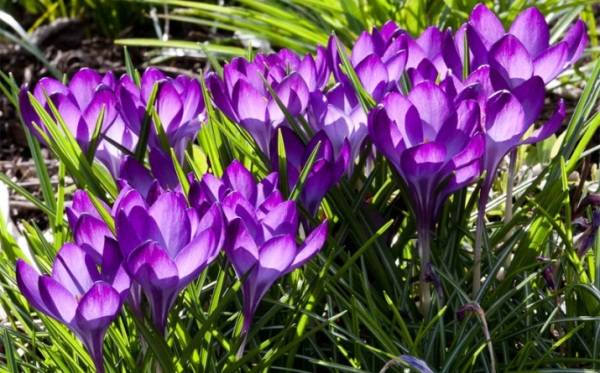

Crocuses
The flower season opens with beautiful lilac flowers called crocuses, the first messengers of spring.
Low-growing bulbous plants up to 10 cm high... Crocuses are planted in spring in sunny places, although they grow almost everywhere, since the period of their growth and flowering falls on the time when the garden plants are just waking up and the shadow from them does not bother them too much. Sand, humus, lime and ash are added to the soil for planting.
Hyacinth
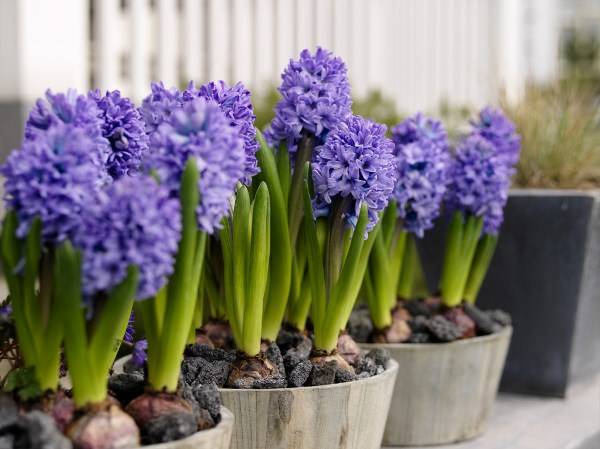

Hyacinth
Fragrant hyacinths pick up the baton of spring flowering after crocuses.
The uniqueness of hyacinth is that it can be grown both in the garden and at home. Like all bulbous hyacinths, hyacinths are planted in autumn, in sunny fertile areas. Planting depth should be 15-20 cm... After flowering and dying off of the leaves, the bulbs are dug up and transplanted to new places annually in order to avoid fungal diseases.
Iris
It is difficult to imagine a garden in late spring without purple irises.
There are several types of irises differing in the shape of the flower and the width of the leaves.:
- bearded irises - named due to the presence of colored hairs on the lower fouls, resembling a beard;
- siberian - unpretentious and frost-resistant, the size of the flower is smaller than that of the bearded and their leaves are narrow and more rigid;
- japanese - heat-loving and unpretentious, drought-resistant, requiring abundant watering only during the flowering period. They differ from other species in the orchid-like shape of the flower and in the absence of smell.
Irises grow best in sunny areas, but they also tolerate light partial shade. The main thing when planting is not to deepen the rhizomes, it should be at the level of the soil, otherwise flowering will come only as the rhizome grows and comes to the surface.
Lilac
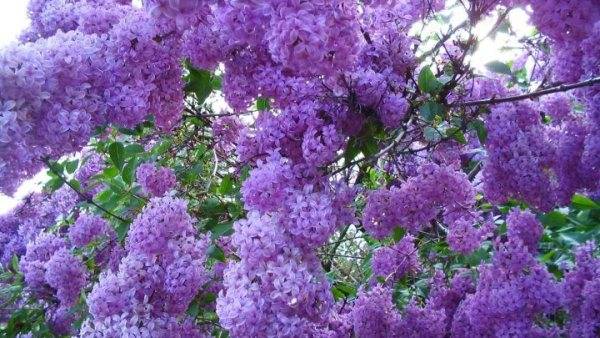

Lilac
Lilac is a shrub that bewitches with its beauty and heady aroma. Unpretentious, loving sunlight and pruning inflorescences immediately after flowering.
Rhododendron
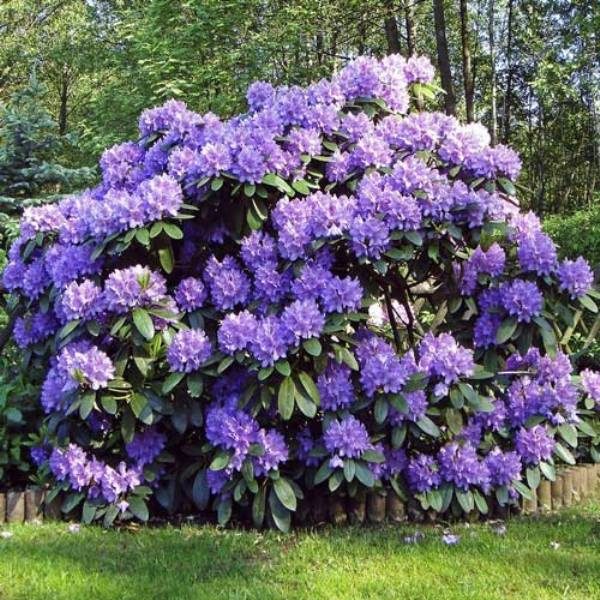

Rhododendron
Rhododendrons are thermophilic "sissies", capricious to growing conditions and poorly hibernating in cold Russian winters. They grow only in the shade, do not bloom in sunny areas. Soils for growing need acidic and well-moistened, they love spraying on the leaves, especially in the heat... For reproduction, it is necessary to purchase bushes 2-4 years old.
Buddlea
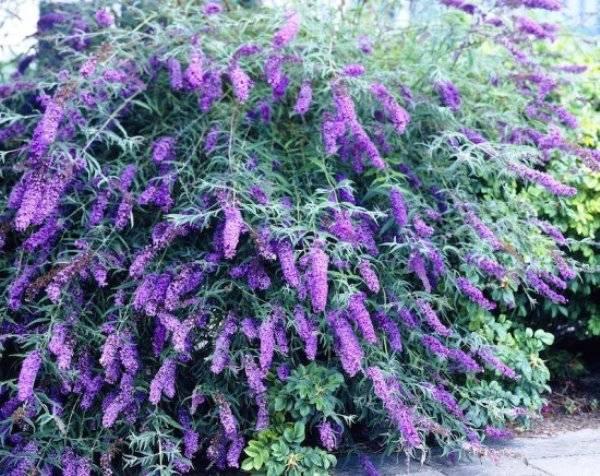

Buddlea
Buddleya is a deciduous shrub up to 2-3 m high with spicate, drooping inflorescences, reaching a length of 0.5 m. When blooming, flowers emanate a honey aroma.
The shrub begins to bloom from the age of 3, flowering begins in July and lasts until October, subject to the constant removal of fading inflorescences. Before flowering, nitrogen and organic fertilizers are applied, with the beginning of flowering, they switch to phosphorus-potassium fertilizers.
For the winter, the plant needs a mandatory shelter.
Cat mint
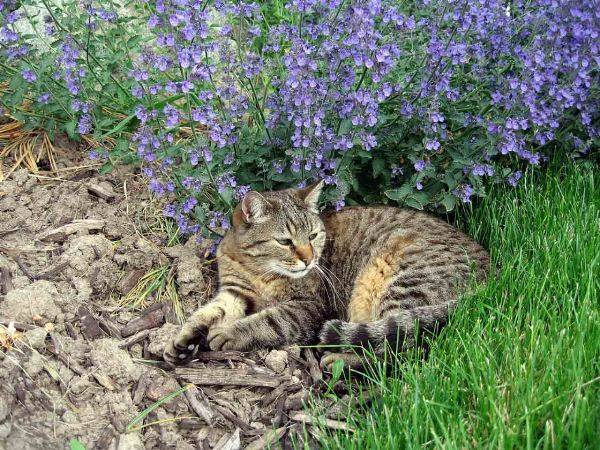

Cat mint
Catnip, also known as catnip lemon perennial herb up to 1 m high... A very moisture-loving plant that prefers sunny areas.When planted in the shade, the plant stretches in height, in the sun it grows in breadth. The plant is frost-hardy and tolerates drought well, but short-term.
Lilies
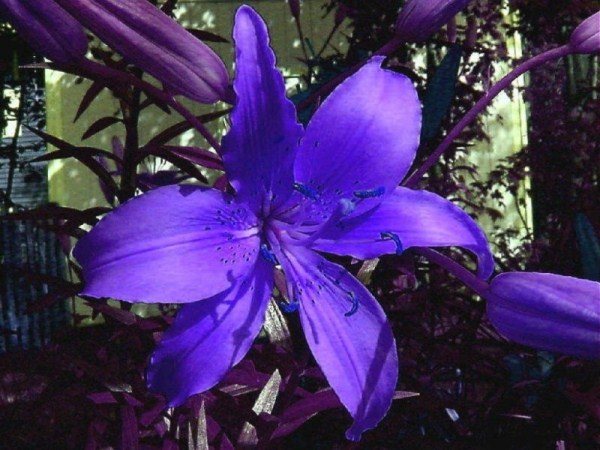

Lilies
A flower whose beauty is breathtaking.
Like all bulbous flowers, they are unpretentious in growing. When planting, maintain a planting depth of 3 bulb heights, further care: watering, feeding and removing faded stems.
Gladioli
The decoration of any flower bed is a noble gladiolus.
A bulbous plant in which the corm is renewed annually, i.e. the old one dies off, forming one or two new ones in its place. The most successful places for planting gladioli are sunny, protected from cold winds with light fertile soil.
To ensure long-term and intense flowering, gladioli need 4-fold feeding:
- 1st - nitrogen in the phase of formation of 3-4 leaves;
- 2nd - complex fertilizer in the budding phase;
- 3rd and 4th - phosphorus-potassium at the beginning and during flowering.
Clematis
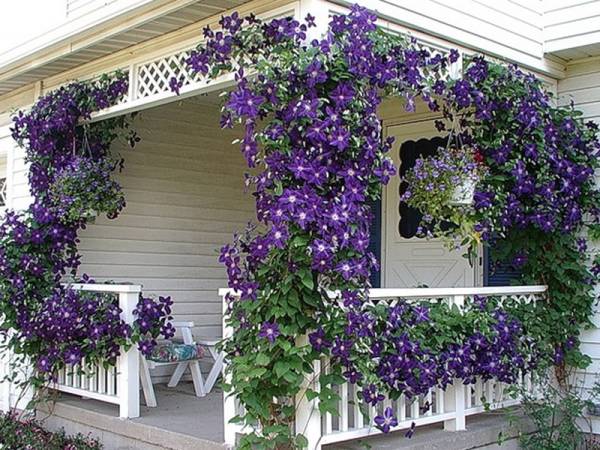

Clematis
The king of lianas clematis is indispensable in garden plots in vertical gardening. They decorate gazebos, verandas, plant together with roses. Liana is unpretentious, care consists in watering, mulching the soil under the bushes, because the plant does not tolerate overheating of the roots, dressing... Providing minimal care, you can get abundant flowering.
If you want to bring a feeling of peace and tranquility to your site - decorate it with flowers of purple shades, their choice is huge.
During the Renaissance, violet products were only available to members of the royal family and high clergy, since the dye extracted from the shellfish that live in the Mediterranean was very expensive. Violet (magenta) color is still associated with wealth, power and power, despite the fact that this paint is now available to everyone.
Violet is obtained by mixing blue and red, this color has many shades from pink to lilac. Decreasing the amount of blue results in a shift towards pink, and a decrease in red shifts the color towards magenta. Cool shades of pink and purple look interesting against a gray sky. This color palette is great for humid climates where fog is often prevalent. Warm shades of burgundy and red look solemn and elegant in the garden.
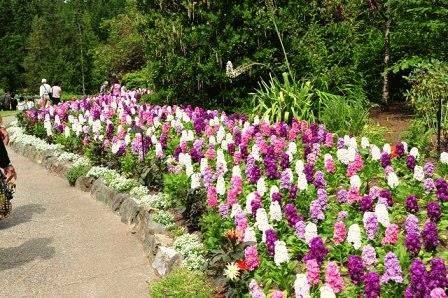

Various shades of blue and violet colors create a sense of the distance of the subject and visually increase the space. Garden paths framed by lavender and catnip seem to be longer than they really are. Most shades of purple go well with silvery foliage.
Another classic combination is purple with white and yellow flowers (yellow is the complementary color for purple). The bright yellow foliage makes a colorful contrast to the eggplant palette. The landscape composition of purple irises and yellow krasodnev looks spectacular.
The predominance of red in purple makes plants of this color range invisible in the dark. The pinkish palette fades quickly in the daytime.
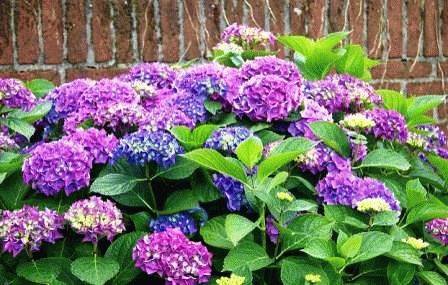

Violet (purple) flowers
Many flowers are mistakenly called blue, in fact, they are purple. The range of plants in the truly blue color range is very limited. Among them are spreading lithospermum, meconopsis drop-leaf, blue tweed, Cape Ankhusa, evolvulus, plumbago, ceratostigma, forget-me-not, blue cornflower, stemless gentian.
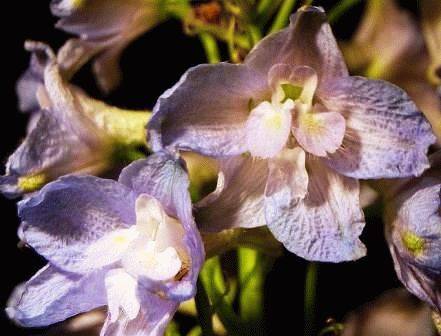

The delphinium stands apart in this list - the quintessence of blue and purple colors.
Popular garden plants of the violet range are agapanthus, cyanosis, jasmine nightshade, catnip, iris, geranium, sacred vitex, veronica, lilac, lupine, bell, some varieties of hydrangea.
Flowers of the following ornamental crops have a rich dark purple color: yarrow "Summer Wine", polyglass, rudbeckia, penstemon "Sour Grapes" and "Midnight Salvia", Salvia varieties "Indigo Spiers" and "Purple Rain", sedum "Autumn Joy", limonium, trachelium. Felicia, petunia and lobelia form a magnificent lilac-purple flower garden palette.
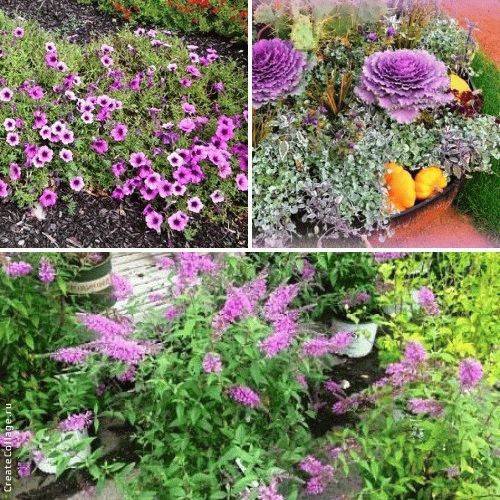

Shade-loving plants
Purple not only visually expands the space, it also emits a soft glow, which makes plants of this color range ideal for landscaping shady forest gardens. Lilac, purple and blue flowers will revive the shady areas of the garden, make them play with new colors.
Scylla, which is planted under trees and bushes, is especially popular among gardeners. In the spring, the scilla blooms with beautiful bluish-lilac flowers. The plant bulbs are planted in the fall. Scyllas are unpretentious, willingly grow in full shade, and in bright sun, preferring partial shade. Another popular garden culture is muscari, inflorescences of small blue flowers are highly decorative.
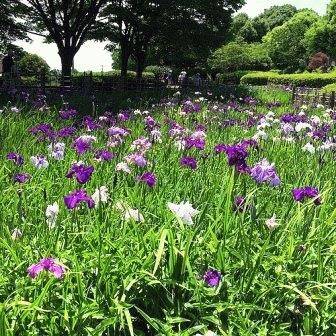

Bells can be attributed to spectacular shade-loving soil-covering plants, for example, Pozharsky's bell, pleasing with abundant and long flowering starting in late spring. For landscaping small gardens, a Carpathian bell is suitable. Its flowering period is somewhat shorter than that of the previous species, but its single purple flower cups on thin leafy stems can decorate any garden. Geranium also tolerates partial shade well, its beautiful bright flowers appear in spring.
Violets - the self-explanatory name of these flowers is associated with this color scheme. One of the most common types of violets is an old and indispensable inhabitant of the garden, the fragrant violet, the great-grandmother of many now popular species. It forms fragrant flowers of various colors, white, lilac or pink.
Before buying a plant, make sure it smells good, as some flowers have very little fragrance. Among the variety of species, the Labrador violet deserves special attention - a short, hardy plant with dark purple flowers and lilac-purple leaves.
Both varieties of perennials prefer moist, well-drained soils and shady locations. Annual violets, or, as they are commonly called, viols, are a hybrid of Wittrock's F1 viola. The color of their flowers is extremely varied, the whole range of colors from orange and yellow to pink, white, blue and, of course, purple.
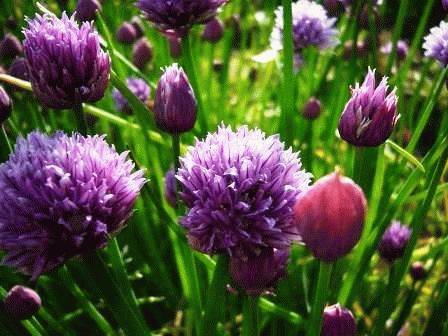

Plants with purple (purple) foliage
The purple foliage range ranges from reddish brown to bluish black. This palette is the perfect backdrop for reds, purples and pinks. In addition, purple foliage forms bright contrasting combinations with golden hues.
For the color to retain its intensity and expressiveness, plants need sunlight. Yellow plants will look great against a backdrop of reddish purple maple leaves. The classic landscape composition, loved by many designers, in the foreground a plum spread ‘Nigra’ with purple leaves, and in the back - an elm with creamy yellow foliage.
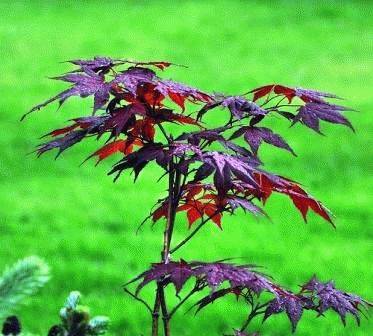

The spectacular deciduous shrubs include the Thunberg barberry. In landscape gardening, varieties with rich purple foliage with a golden border and varieties with variegated leaves decorated with pink specks are especially popular. Often, designers plant two varieties next to each other, their unusual foliage perfectly complements each other, and in the fall, the flaming barberry bushes look fabulously beautiful.
Koprosma creeping is an attractive plant with a rich color range of leaves from the dark purple Tago palette to the rich chocolate shades of Cappuccino. Against their background, golden accents look most colorful.A picturesque composition of perennials combined with lush decorative cannes (Black Knight, Striata, Tropicana) will decorate any area.
The lower tier of the garden is formed by herbaceous plants with original foliage coloration. For landscaping shady areas, use Purpurea purple Tradescantia in combination with purple loosestrife or White Nancy.
In an arid climate, succulents such as aeonium tree ‘Zwartkop’ and Mexican sedum ‘Gold Mound’ do well and get along well with each other.
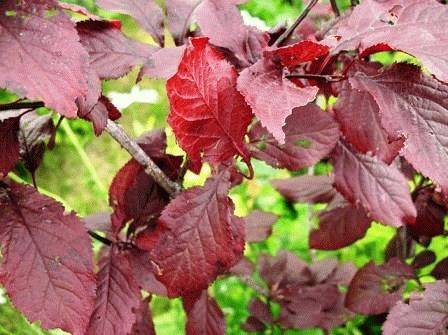

Plants with violet (purple) palette foliage: Ground cover plants and annuals: Catlins Giant tenacious, garden purple quinoa, cabbage, irezine, coleus.
Perennials: canna (bronze leaves of the Purpurea variety), dahlias of the Bishop of Llandaff and Yellow Hammer varieties, crested eucomis Purple, Heuchera, Purpureum New Zealand flax, Brazen Hussy spring buttercup.
Shrubs: Akalifa Wilkes, 'Plumtastic' azalea, purple-leaved barberry, fuchsia three-leafed, 'Black Stallion' lofomirt, strobilantes.
Trees: Atropurpureum palm-tree maple, Forest Pansy canadian scarlet, Purpurea sticky dodonea, purple forest beech, Ruby Lace three-prickled gledigia, purple apple tree, spreading plum Nigra.
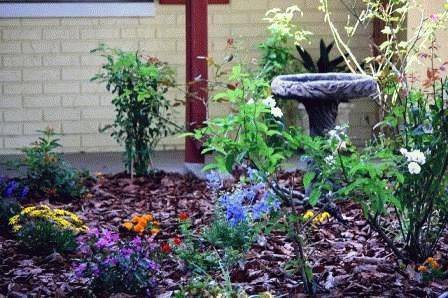

den-
Ginura - a flower with purple leaves
Belongs to the Asteraceae family and has about 50 species of lilac and burgundy flowers with different names. Carved wavy leaves are covered with fine purple hairs, pleasant to the touch.
Does not require special care, the main condition for successful cultivation is bright lighting during daylight hours.
If the plant feels a lack of light, the hairs will turn green, which will affect the attractiveness.
Basic conditions for proper care:
- loose soil with neutral acidity, consisting of leafy, soddy soil and river sand;
- abundant watering as the topsoil dries up;
- content in summer at a temperature of 20-24 degrees;
- in winter with a lack of natural light temperature drop to 13 degrees, when kept in warmer conditions, additional illumination with fluorescent or phytolamps is mandatory;
- humidity does not matter;
- feeding during the period of active growth every 2 weeks;
- propagation by cuttings is quick and easy.
Every 2 years, it is advisable to rejuvenate her - cut off the apical cuttings and root... Otherwise, the flower loses its attractiveness - it turns pale and stretches ugly.
Irezine
A bright houseplant from the Amaranth family. In the wild, there are over 80 species of this flower, the home of which is the Antilles, America and Australia. There are several life forms - herbaceous plants, shrubs and shrubs, and even trees with climbing branches. At home, only a few types are used.
Herbst
Iresine herbstii is a perennial, herbaceous plant, not exceeding 40 cm in height. The leaves are round, with red veins running along the upper part. In the wild, it grows in the tropics of Brazil. Stems are red, flexible. The shape of the leaf blade is round, heart-shaped. The plant has red petioles and shoots.
There are two varieties of this cultivar - aureoreticulata and wallisi. The first has golden or red streaks on the surface of green leaf blades. The foliage of the second grade is green with a metallic color. The plant is branched, the leaves are small, the bush grows compact. The reverse side of both varieties is deep purple.
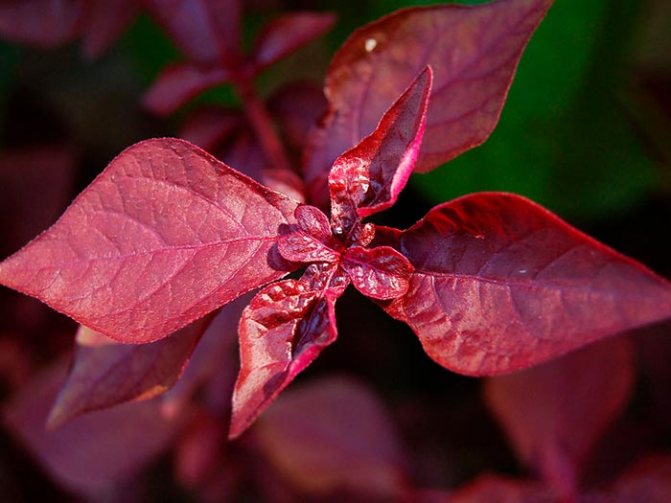

Linden
Iresine lindenii is an exotic ornamental flower that is prized for the appearance of its leaves. Herbaceous perennial grows in the wild in the tropics of Ecuador. The stem is dark red, no more than half a meter high. The foliage is reddish purple. On the upper part, it is dark green with thick crimson veins. Heart-shaped, with a pointed tip. The length of one leaf reaches 6 cm. With timely pruning, the plant branches, young shoots grow quickly.
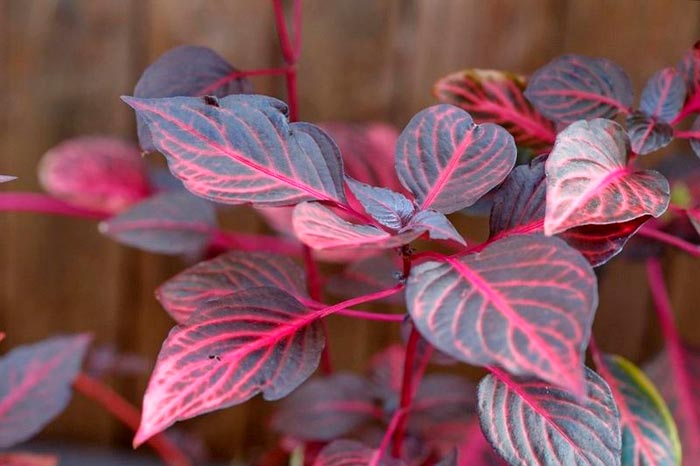

Purple lady
An ornamental, highly branched bush with leaves of a dark purple or violet hue. Ground cover crop, grown in ampel form as an independent plant, in mixed compositions and in pots. Height - 20 cm, width can reach more than 120 cm.The leaves are small, with a pointed tip, from the seamy side - burgundy-purple, outside there are thin silvery veins.
Unpretentious and beautiful
If you are looking for lilac flowers that are spectacular and easy to care for, then irises are perfect for you. Their palette is very wide, there are only fiery red species in it. And there are many shades of lilac. They bloom in early summer, there are varieties with re-flowering later. Some species have a delicate, delicate aroma, and some have almost lost it in the process of selection, but they have become larger and acquired an interesting color.
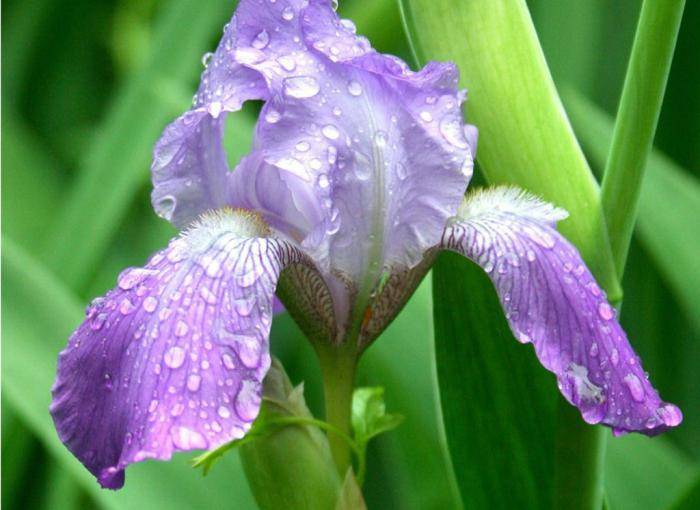

Irises need at least 6 hours of sunshine a day - the more the better. Their rhizomes should not be covered with earth, otherwise they may begin to rot, and this is detrimental to the plant. For the same reason, the soil should be light, with an admixture of sand, and mulching should not be used so that moisture does not accumulate.
Irises are self-sufficient plants, they feel best in planting together with relatives. However, do not forget to leave enough space between them, because they grow quite quickly, and you should be able to freely divide the bushes as needed (every 3-4 years).
Irises reproduce by rhizomes. Although they produce seeds, it is not recommended to grow plants from them, as this rarely allows you to maintain varietal characteristics. Planting planting material or dividing the bush is done in August.
For the winter, the foliage must be cut off.
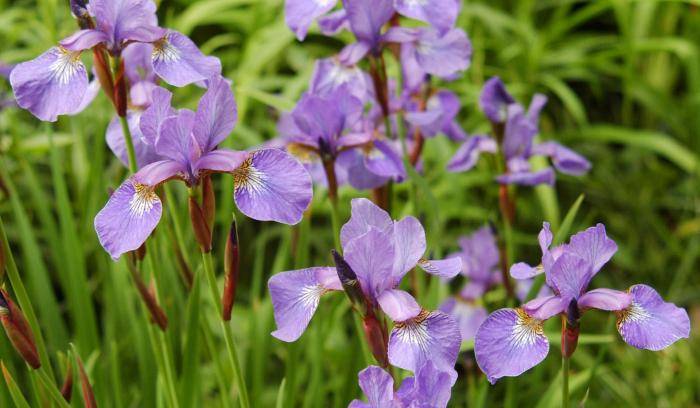

As you can see, not only the lilac branch boasts a delicate color and aroma, it has many other equally worthy competitors. Although it is better to say - companions, because you should not limit yourself in beauty.
Unusual handsome
Many kids don't like onions, but rest assured they will love this variety. It's about allium. He has giant flower balls with lilac flowers-crumbs on a stem 80-150 cm high.
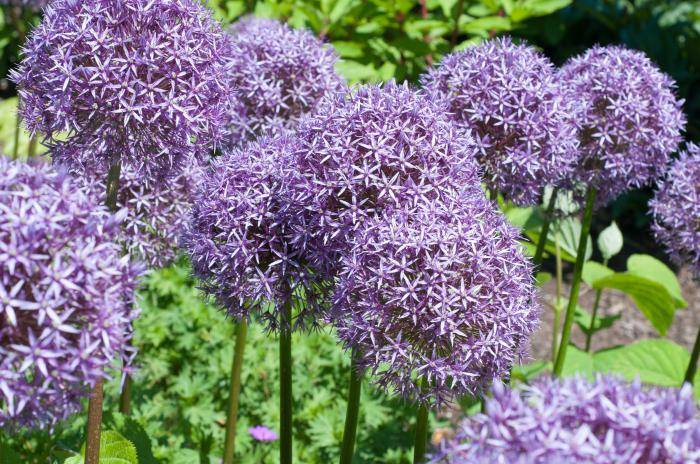

And with all this, allium (gigantic onion) is a plant that is easy to care for, and even perennial. It is unpretentious to the soil, but does not tolerate stagnation of moisture and, in general, copes well with drought. He needs a lot of sunlight, but it is advisable to plant this flower in closed, wind-free areas.
The only condition put forward by Allium is an autumn planting. In this case, the bulb must be buried in the soil to a depth equal to its four diameters and leave a free space between them, at least 20 cm. If the soil is not rich, it must be fertilized.
Different varieties of allium bloom at different times, but after flowering, its foliage dies off, so you should make sure that other plants cover it, and the flowerbed is not empty.
Transfer
A young plant needs to be replanted annually, and when it reaches 4 years of age - once every 2-3 years, otherwise the flower will lose its decorative effect. The best time for this is early spring.
Reasons for sour acid transplant:
- the plant has grown greatly;
- more than a week has passed after buying a flower;
- the flower is sick.
The transplant must be carried out carefully, avoiding damage to the roots - the further adaptation and rooting of the plant depends on the degree of care in removing the flower.
Transplant instructions
- prepare the soil and a new pot;
- pour a drainage layer 2 cm thick into the container and cover the soil;
- water the plant abundantly, then remove it from the old flowerpot;
- put the sour into a new flowerpot;
- fill the voids with the remnants of the soil mixture, maintaining the same soil level;
- pour over the acid lily and place it in a dimly lit place.
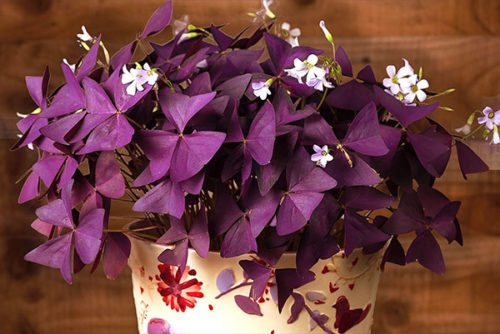

It is not necessary to remove all the substrate from the root system - this will slow down the adaptation process.
With the correct transplantation and providing the necessary conditions for the plant, the flower fully takes root within 2-3 weeks.
Irises and crocuses
There is a legend that the very first iris blossomed millions of years ago in the subtropical forests of Southeast Asia. In the 14-15 centuries BC. e.purple flowers were bred in ancient Egypt. There, iris was considered a symbol of eloquence. Later, this flower appeared in Spain, France, England and Russia and other countries.
In Russia, iris had the most unexpected names. They were also called cockerels and magpies and pigtails. But the most common is iris, meaning "dear and beloved."
Iris bloom from May to July. The best time to plant is right after flowering ends. Irises grow and bloom in one place for 5 years.
A beautiful little flower with a small yellow center is called a crocus. With the first rays of the spring sun, these flowers are among the first to bloom. They delight gardeners on the site, and lovers of home flowers can grow them on the windowsill.
Crocus belongs to the iris family. These are low, perennial bulbous plants. These bright yellow, blue, white, purple flowers grow throughout Europe and Asia.
Planting crocuses on the site will not cause much trouble, because there are no weeds yet, so you don't have to weed, and the soil is moist enough. But the soil should be selected in such a way that moisture does not stagnate in it; soil with high acidity is suitable.
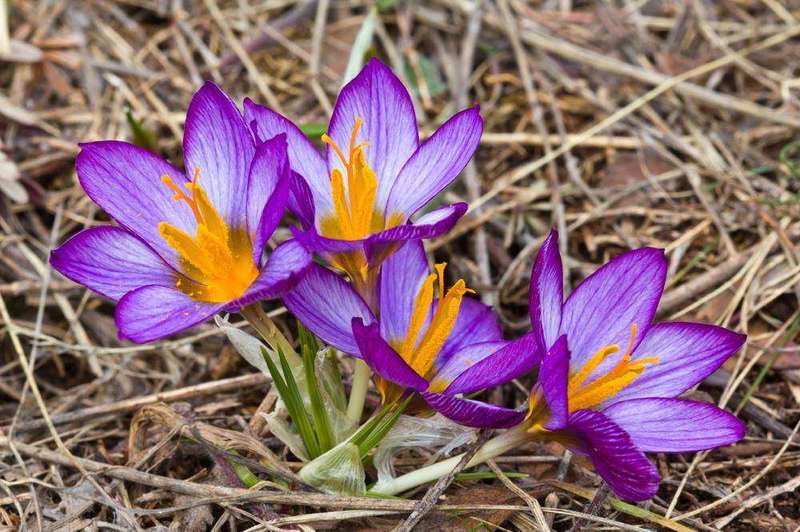

Crocuses blooming in autumn are planted in late July, and spring crocuses in autumn. It should be noted that crocuses grow rapidly, so the distance from one bulb to another should be significant - about 10 cm. After flowering, the bulbs must be dug up and stored in a dry place until the beginning of the next season.
Description of the breeding process with a photo
Indoor flowers reproduce well at home. Most often, in order to grow a new plant, it is necessary to take a viable shoot of the mother culture, properly process it and plant it in the ground.
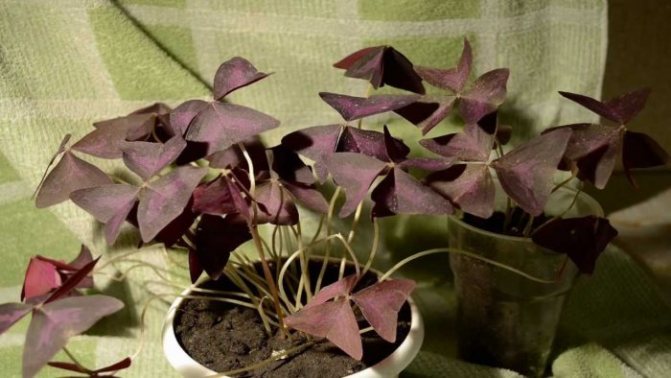

To do this, you need to choose a cutting that is not damaged. It is cut off with a sharp knife at an angle. The cut site is treated with crushed charcoal. Then the shoot is placed in a substrate (for example, in water) until strong roots are formed on the cut. After that, it is planted in a nutritious, pre-moistened soil, watered.
Important! For reproduction, shoots are chosen, on which there are several buds, from which leaves will develop in the future.
Every indoor plant needs a lot of attention and care. And only under such conditions will it actively grow, develop, delight the owner with large and bright colors of all shades of purple.
Reproduction
Nature itself has come up with a very convenient way of reproduction for rheo - by lateral processes. In the tropics, this gives the plant the ability to easily and quickly expand its habitat.
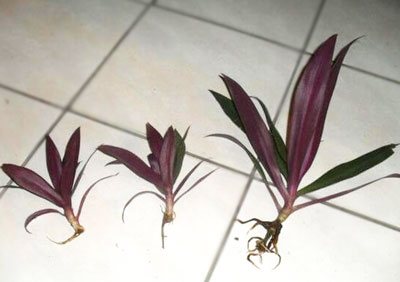

At the same time, the varietal characteristics of the maternal rheo remain completely.
This rule is not violated in the process of home breeding.
However, flower growers love to experiment, which means that you can try to increase the "plantation" of rheo by sowing seeds.
Seeds
If the plant has received enough heat and moisture from the sun, the seeds ripen well.
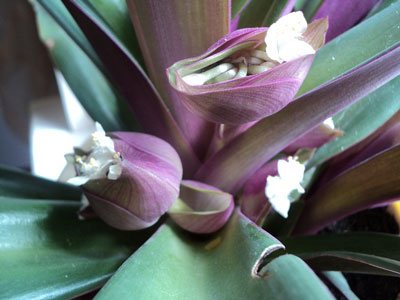

Before planting, they are soaked in water with the addition of a drug that stimulates growth.
Planting begins in a day.
It is not necessary to press the seeds into the soil; it is enough to sprinkle it on top with a 2 mm layer of soil.
With the help of a plastic bag, they construct a kind of greenhouse and patiently wait (from time to time moistening the soil) from two to six weeks for the emergence of shoots.
All this time, it is advisable to maintain the temperature in the room at 20-22 degrees. The "greenhouse" is removed after the formation of two true leaves.
A selection of photos
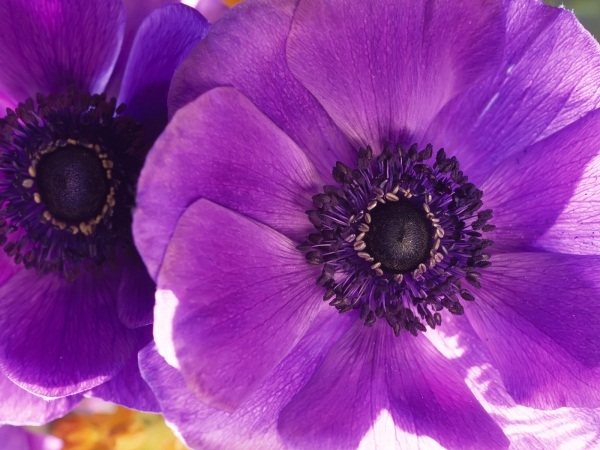

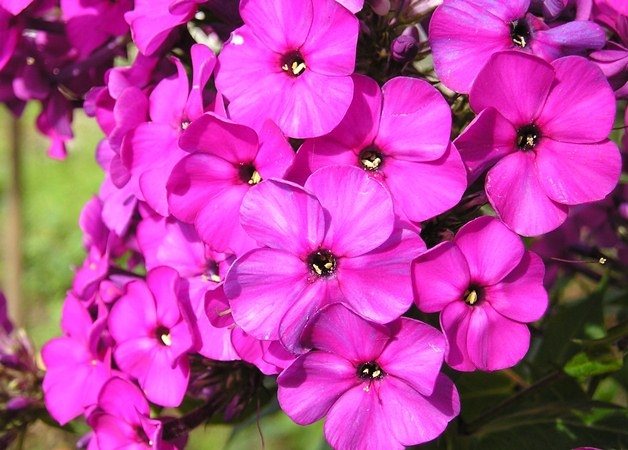

Luxurious aquilegia
If you plant this plant on your site, then be prepared in advance for the delight of guests, the envy of neighbors, and the questions: "What is the name of the lilac flower?" Because it is impossible to pass by the aquilegia and not admire it.The name comes from the Latin aquila - eagle, due to the similarity of slightly protruding petals with the outstretched wings of a bird.
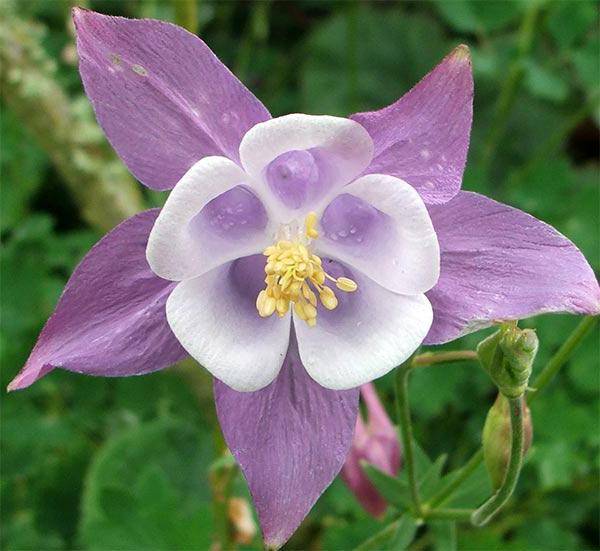

Aquilegia can be propagated by seeds: they are sown in mid-spring. But in this case, the plant will bloom only next year. If this does not suit you, then you can buy aquilegia cuttings or already adult plants.
Delphinium and Muscari
The soil for planting these flowers should be slightly acidic, slightly moistened. It blooms well both in sunny places and in the shade. The fertility of the soil affects the size of the bulbs, the appearance of flowers. Mouse hyacinth should be fertilized with compost or humus.
Craftswoman Nature, skillfully playing with various colors and shades, creates incredible beauty compositions that you want to repeat on your personal plot. When forming a future pictorial masterpiece, the main stake can be made on the purple color, which conveys emotionality, great sensitivity, high spirituality and is optimal for meditation and contemplation.
This "cold" color is ideal for dreamy people who are carried away in their fantasies far beyond the bounds of the possible, this favorite color of intellectuals and harmoniously developed people has a positive effect on brain activity.
About the benefits and harms of the Reo flower
In folk medicine, the hero of the article is not very popular, but the Reo flower can also be beneficial. There are several recipes that help with rheumatism, skin damage (wounds) or intestinal diseases and even bleeding. With rheumatism, heated leaves are applied in the form of a compress to the joints. With open wounds, the washed leaves are ground and this composition is applied to the sore spot and bandaged. For problems with the intestines, dysentery or intestinal bleeding, use a decoction of Reo flowers, boiled for 20 minutes.
Beautiful, aromatic and healthy
Listing flowers with lilac flowers, one cannot but recall lavender. With it, on your site will not only be a piece of French Provence, but also an excellent source of raw materials for homemade pillows and pouches that help relieve stress and fall asleep. If you put them in a closet, then things will not only acquire a subtle scent, but you will also get rid of the moth, which does not like this plant.
Lavender grows as long-stemmed bushes on which small flowers are placed.
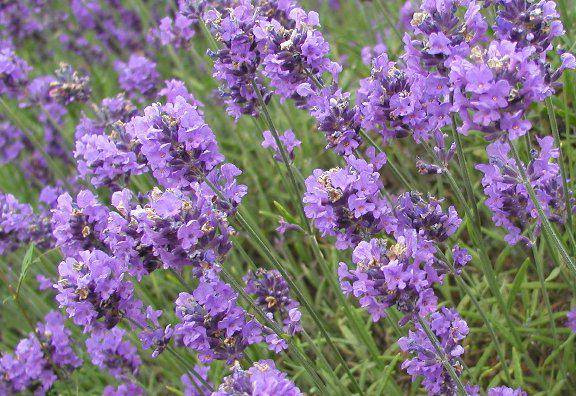

Propagated by seeds, which is very laborious, or by layering. It is also available for sale in the form of adult plants in flowerpots.
It should be remembered that this is a thermophilic plant, so if you have a cool climate, it is best to keep it in pots and bring it indoors when the temperature drops.
The main condition for the successful growth of lavender is a sunny and ventilated area, with light sandy soils that drain moisture well. However, she loves watering, the main thing is that the water does not linger. Otherwise, the plant can become a victim of fungal diseases.

